
Netty 概述
原生 NIO 存在的问题
NIO的介绍见【Java】NIO
NIO 的类库和 API 繁杂,使用麻烦:需要熟练掌握 Selector、ServerSocketChannel、SocketChannel、ByteBuffer等。- 需要具备其他的额外技能:要熟悉
Java 多线程编程,因为 NIO 编程涉及到 Reactor 模式,你必须对多线程和网络编程非常熟悉,才能编写出高质量的 NIO 程序。
- 开发工作量和难度都非常大:例如客户端面临断连重连、网络闪断、半包读写、失败缓存、网络拥塞和异常流的处理等等。
JDK NIO 的 Bug:例如臭名昭著的 Epoll Bug,它会导致 Selector 空轮询,最终导致 CPU100%。直到 JDK1.7 版本该问题仍旧存在,没有被根本解决。
Netty 官网说明
官网:https://netty.io/
Netty is an asynchronous event-driven network application framework for rapid development of maintainable high performance protocol servers & clients.
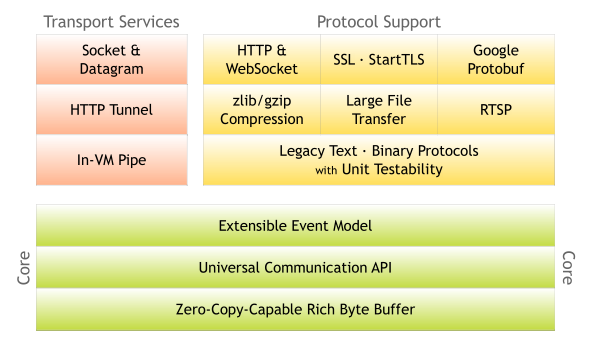
Netty 的优点
Netty 对 JDK 自带的 NIO 的 API 进行了封装,解决了上述问题。
- 设计优雅:适用于各种传输类型的统一
API 阻塞和非阻塞 Socket;基于灵活且可扩展的事件模型,可以清晰地分离关注点;高度可定制的线程模型-单线程,一个或多个线程池。
- 使用方便:详细记录的
Javadoc,用户指南和示例;没有其他依赖项,JDK5(Netty3.x)或 6(Netty4.x)就足够了。
- 高性能、吞吐量更高:延迟更低;减少资源消耗;最小化不必要的内存复制。
- 安全:完整的
SSL/TLS 和 StartTLS 支持。
- 社区活跃、不断更新:社区活跃,版本迭代周期短,发现的
Bug 可以被及时修复,同时,更多的新功能会被加入。
Netty 版本说明
Netty 版本分为 Netty 3.x 和 Netty 4.x、Netty 5.x。目前推荐使用的是 Netty 4.x的稳定版本。
博客参考:https://dongzl.github.io/netty-handbook/#/_content/chapter01
Netty 高性能架构设计
线程模型基本介绍
目前存在的线程模型有:传统阻塞 I/O 服务模型 Reactor 模式。
根据 Reactor 的数量和处理资源池线程的数量不同,有 3 种典型的实现:
- 单
Reactor 单线程;
- 单
Reactor多线程;
- 主从
Reactor多线程
Netty 线程模式主要基于主从 Reactor 多线程模型做了一定的改进,其中主从 Reactor 多线程模型有多个 Reactor
传统阻塞 I/O 服务模型
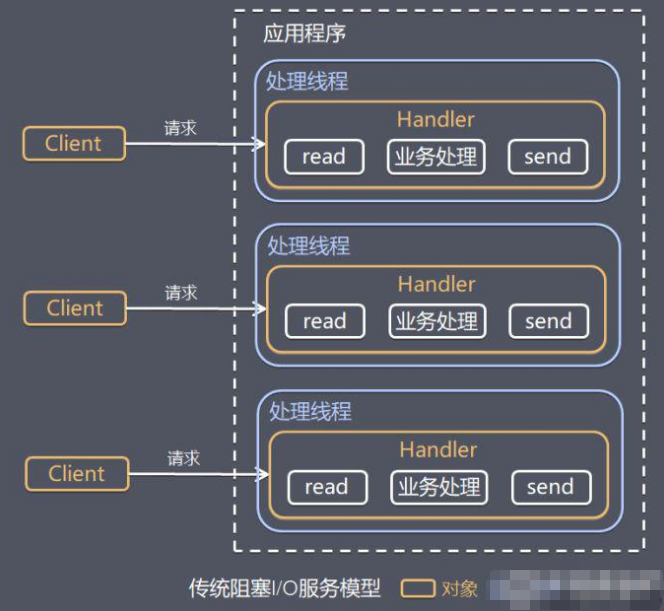
黄色的框表示对象,蓝色的框表示线程,白色的框表示方法(API)
模型特点:
- 采用阻塞
IO 模式获取输入的数据
- 每个连接都需要独立的线程完成数据的输入,业务处理,数据返回
问题分析:
- 当并发数很大,就会创建大量的线程,占用很大系统资源
- 连接创建后,如果当前线程暂时没有数据可读,该线程会阻塞在
read 操作,造成线程资源浪费
Reactor 模式
针对传统阻塞 I/O 服务模型的 2 个缺点,解决方案:
- 基于
I/O 复用模型:多个连接共用一个阻塞对象,应用程序只需要在一个阻塞对象等待,无需阻塞等待所有连接。当某个连接有新的数据可以处理时,操作系统通知应用程序,线程从阻塞状态返回,开始进行业务处理 Reactor 对应的叫法:
- 反应器模式
- 分发者模式(Dispatcher)
- 通知者模式(notifier)
- 基于线程池复用线程资源:不必再为每个连接创建线程,将连接完成后的业务处理任务分配给线程进行处理,一个线程可以处理多个连接的业务。
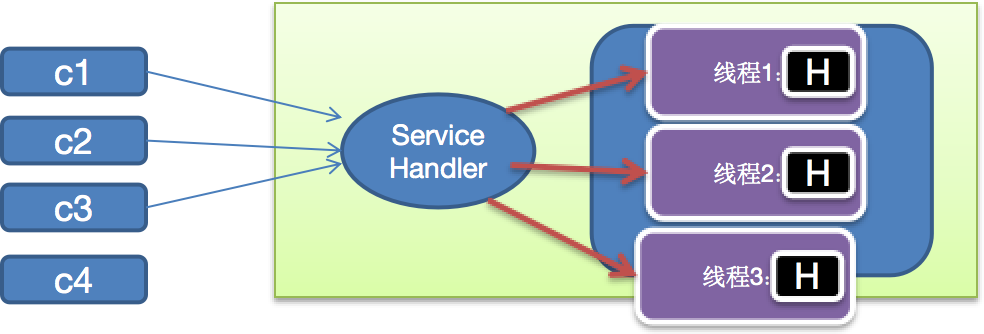
I/O 复用结合线程池,就是 Reactor 模式基本设计思想,如图:
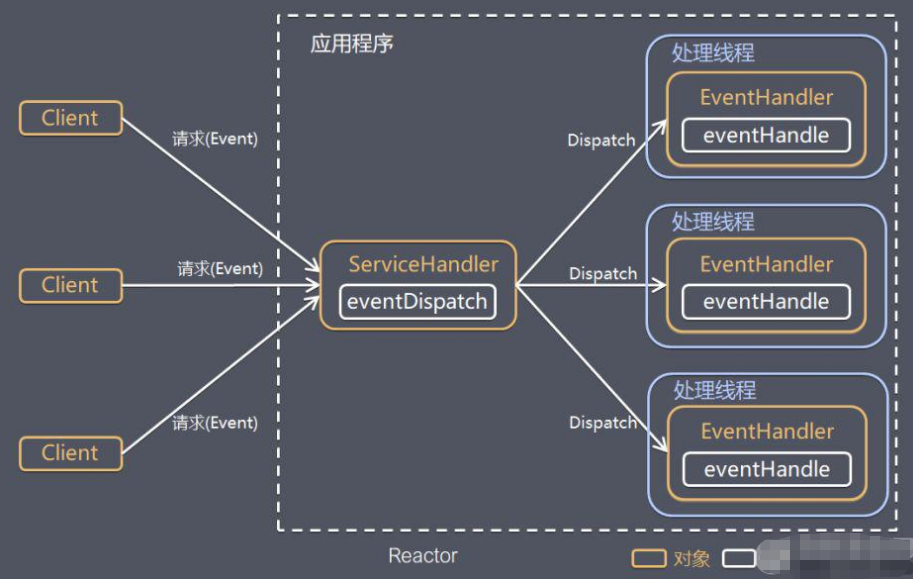
对上图说明:
Reactor 模式,通过一个或多个输入同时传递给服务处理器的模式(基于事件驱动)- 服务器端程序处理传入的多个请求,并将它们同步分派到相应的处理线程,因此
Reactor 模式也叫 Dispatcher 模式
Reactor 模式使用 IO 复用监听事件,收到事件后,分发给某个线程(进程),这点就是网络服务器高并发处理关键
Reactor 模式中核心组成
Reactor:Reactor 在一个单独的线程中运行,负责监听和分发事件,分发给适当的处理程序来对 IO 事件做出反应。它就像公司的电话接线员,它接听来自客户的电话并将线路转移到适当的联系人。
Handlers:处理程序执行 I/O 事件要完成的实际事件,类似于客户想要与之交谈的公司中的实际官员。Reactor 通过调度适当的处理程序来响应 I/O 事件,处理程序执行非阻塞操作。
Reactor 模式分类
根据 Reactor 的数量和处理资源池线程的数量不同,有 3 种典型的实现
- 单
Reactor 单线程
- 单
Reactor 多线程
- 主从
Reactor 多线程
单 Reactor 单线程
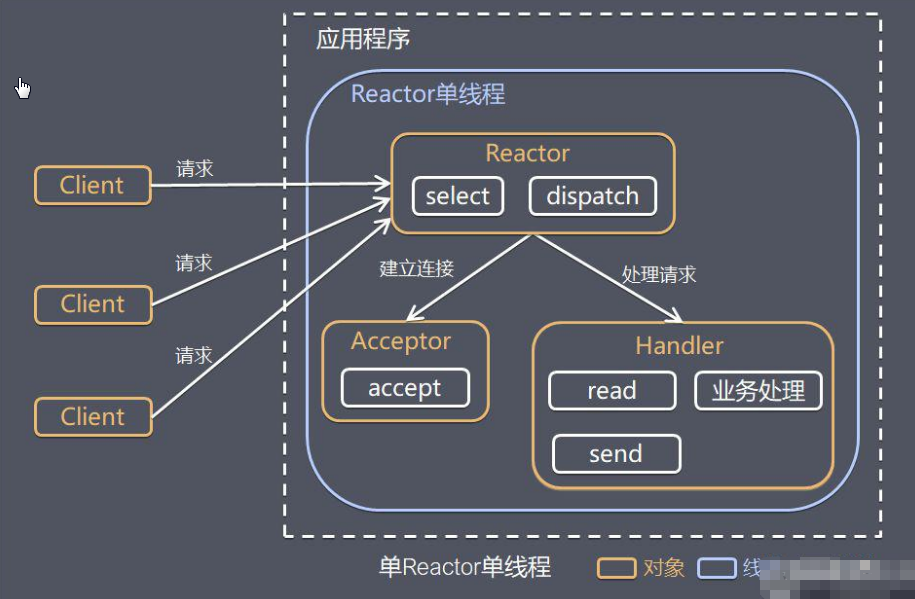
Select 是前面 I/O 复用模型介绍的标准网络编程 API,可以实现应用程序通过一个阻塞对象监听多路连接请求Reactor 对象通过 Select 监控客户端请求事件,收到事件后通过 Dispatch 进行分发- 如果是建立连接请求事件,则由
Acceptor 通过 Accept 处理连接请求,然后创建一个 Handler 对象处理连接完成后的后续业务处理
- 如果不是建立连接事件,则
Reactor 会分发调用连接对应的 Handler 来响应
Handler 会完成 Read → 业务处理 → Send 的完整业务流程
结合实例:服务器端用一个线程通过多路复用搞定所有的 IO 操作(包括连接,读、写等),编码简单,清晰明了,但是如果客户端连接数量较多,将无法支撑,NIO 就属于这种模型。
优缺点分析:
- 优点:模型简单,没有多线程、进程通信、竞争的问题,全部都在一个线程中完成
- 缺点:性能问题,只有一个线程,无法完全发挥多核
CPU 的性能。Handler在处理某个连接上的业务时,整个进程无法处理其他连接事件,很容易导致性能瓶颈
- 缺点:可靠性问题,线程意外终止,或者进入死循环,会导致整个系统通信模块不可用,不能接收和处理外部消息,造成节点故障
使用场景:客户端的数量有限,业务处理非常快速,比如 Redis 在业务处理的时间复杂度 O(1) 的情况
单 Reactor 多线程
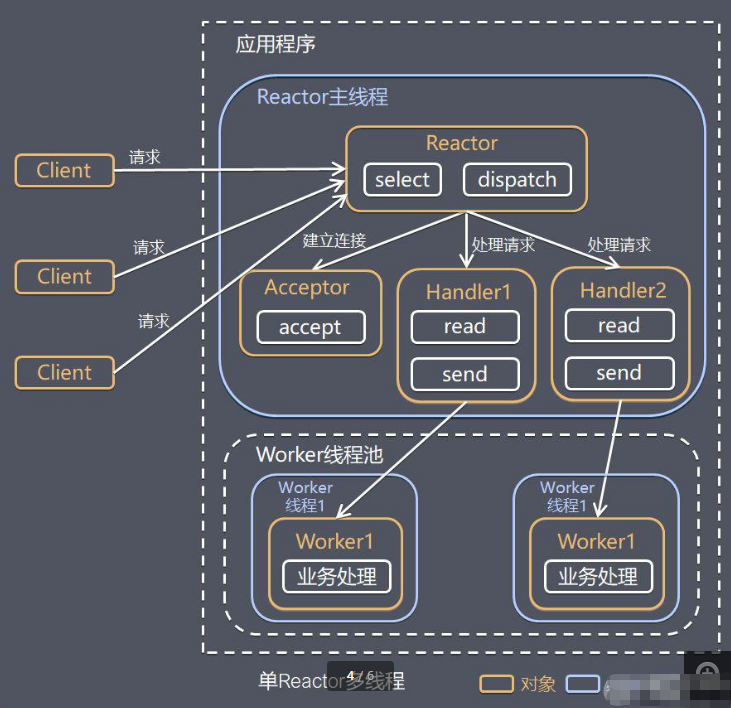
Reactor 对象通过 Select 监控客户端请求事件,收到事件后,通过 Dispatch 进行分发- 如果建立连接请求,则右
Acceptor 通过 accept 处理连接请求,然后创建一个 Handler 对象处理完成连接后的各种事件
- 如果不是连接请求,则由
Reactor 分发调用连接对应的 handler 来处理
handler 只负责响应事件,不做具体的业务处理,通过 read 读取数据后,会分发给后面的 worker 线程池的某个线程处理业务worker 线程池会分配独立线程完成真正的业务,并将结果返回给 handlerhandler 收到响应后,通过 send 将结果返回给 client
优缺点分析:
- 优点:可以充分利用多核
cpu 的处理能力
- 缺点:多线程数据共享和访问比较复杂,
Reactor 处理所有的事件的监听和响应,在单线程运行,在高并发场景容易出现性能瓶颈。
主从 Reactor 多线程
针对单 Reactor 多线程模型中,Reactor 在单线程中运行,高并发场景下容易成为性能瓶颈,可以让 Reactor 在多线程中运行:
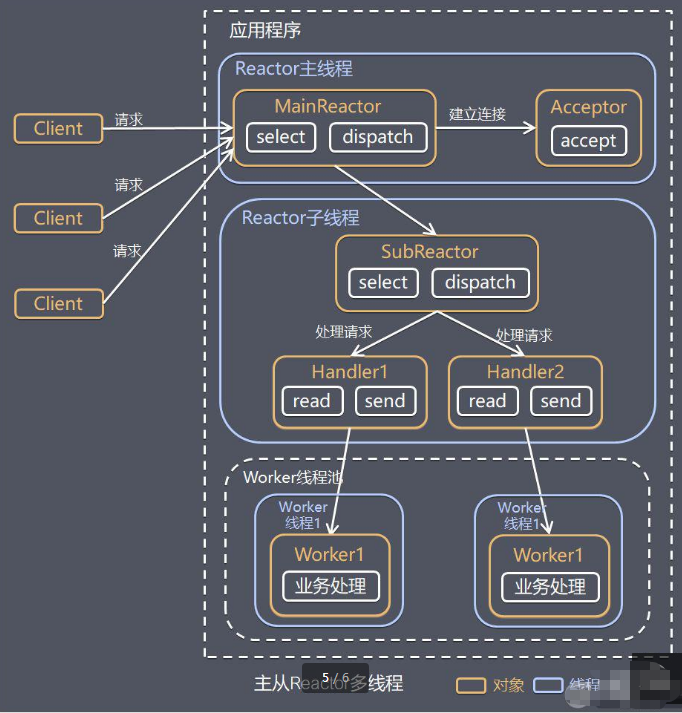
Reactor 主线程 MainReactor 对象通过 select 监听连接事件,收到事件后,通过 Acceptor 处理连接事件- 当
Acceptor 处理连接事件后,MainReactor 将连接分配给 SubReactor
subreactor 将连接加入到连接队列进行监听,并创建 handler 进行各种事件处理- 当有新事件发生时,
Subreactor 就会调用对应的 handler 处理
handler 通过 read 读取数据,分发给后面的 worker 线程处理worker 线程池分配独立的 worker 线程进行业务处理,并返回结果handler 收到响应的结果后,再通过 send 将结果返回给 clientReactor 主线程可以对应多个 Reactor 子线程,即 MainRecator 可以关联多个 SubReactor
Scalable IO in Java 对 Multiple Reactors 的原理图解:

优缺点说明:
- 优点:父线程与子线程的数据交互简单职责明确,父线程只需要接收新连接,子线程完成后续的业务处理。
- 优点:父线程与子线程的数据交互简单,
Reactor 主线程只需要把新连接传给子线程,子线程无需返回数据。
- 缺点:编程复杂度较高
结合实例:这种模型在许多项目中广泛使用,包括 Nginx 主从 Reactor 多进程模型,Memcached 主从多线程,Netty 主从多线程模型的支持
Reactor 模式小结
3 种模式用生活案例来理解:
- 单
Reactor 单线程,前台接待员和服务员是同一个人,全程为顾客服务
- 单
Reactor 多线程,1 个前台接待员,多个服务员,接待员只负责接待
- 主从
Reactor 多线程,多个前台接待员,多个服务生
Reactor 模式具有如下的优点:
- 响应快,不必为单个同步时间所阻塞,虽然
Reactor 本身依然是同步的
- 可以最大程度的避免复杂的多线程及同步问题,并且避免了多线程/进程的切换开销
- 扩展性好,可以方便的通过增加
Reactor 实例个数来充分利用 CPU 资源
- 复用性好,
Reactor 模型本身与具体事件处理逻辑无关,具有很高的复用性
Netty 模型
Netty 模型工作原理图
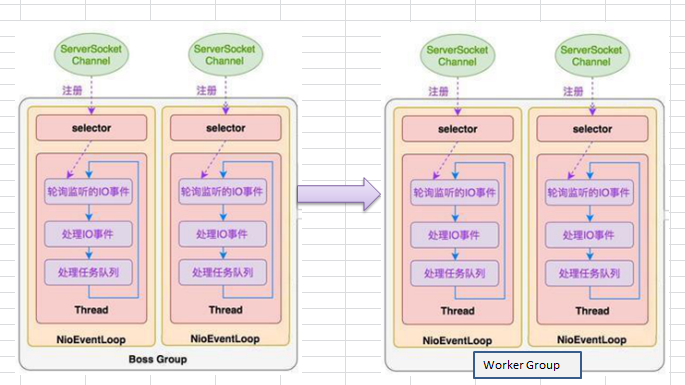
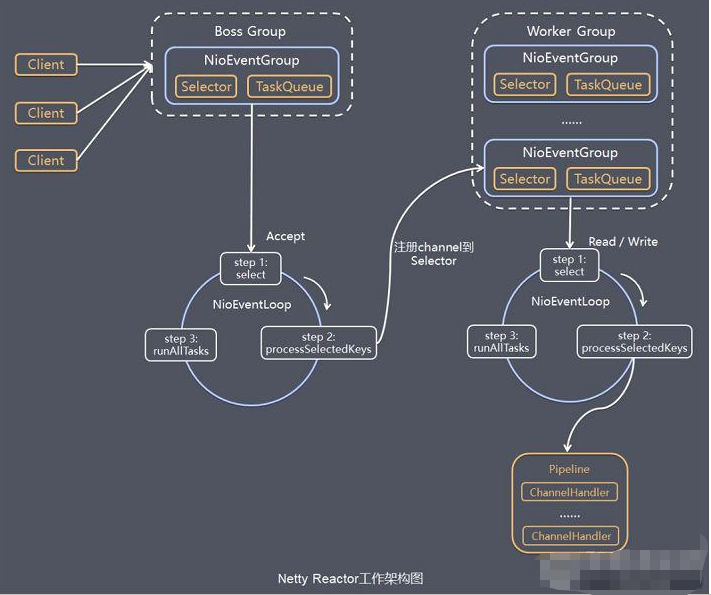
Netty 抽象出两组线程池: BossGroup 专门负责接收客户端的连接,WorkerGroup 专门负责网络的读写。BossGroup 和 WorkerGroup 类型都是 NioEventLoopGroupNioEventLoopGroup 相当于一个事件循环组,这个组中含有多个事件循环,每一个事件循环是 NioEventLoop。NioEventLoop 表示一个不断循环的执行处理任务的线程,每个 NioEventLoop 都有一个 Selector,用于监听绑定在其上的 socket 的网络通讯,该Selector会一直循环查询哪个注册过的Channel有就绪的I/O事件(与NIO原理相同)NioEventLoopGroup 可以有多个线程,即可以含有多个 NioEventLoop
每个BossNioEventLoop循环执行的步骤:
- 轮询
accept 事件
- 处理
accept 事件,与 client 建立连接,生成 NioScocketChannel,并将其注册到某个 Worker 的NIOEventLoop 中的 Selector上
- 处理任务队列的任务,即
runAllTasks
每个WorkerNIOEventLoop循环执行的步骤:
- 轮询
read,write 事件
- 处理
I/O 事件,即 read,write 事件,在对应 NioScocketChannel 处理
- 处理任务队列的任务,即
runAllTasks
每个 Worker 的NIOEventLoop 在处理业务时,会使用 Pipeline(管道),每个Pipeline 都对应了一个 Channel,即通过 Pipeline 可以获取到对应通道,管道中维护了很多的处理器Handler,在管道内按照处理器的注册顺序执行这些处理器,直到所有处理器执行完毕。
总结:
Netty 抽象出两组线程池,BossGroup专门负责接收客户端连接,WorkerGroup专门负责网络读写操作。这两组线程池都是NioEventLoopGroup类型。- NioEventLoop表示一个不断循环执行处理任务的线程,每个
NioEventLoop 都有一个 Selector,用于监听绑定在其上的 socket网络通道。
NioEventLoop 内部采用串行化设计,从消息的 读取->解码->处理->编码->发送,始终由 IO 线程 NioEventLoop 负责
NioEventLoopGroup下包含多个 NioEventLoop
- 每个
NioEventLoop 中包含有一个 Selector,一个 taskQueue
- 每个
NioEventLoop 的 Selector 上可以注册监听多个 NioChannel
- 每个
NioChannel 只会绑定在唯一的 NioEventLoop 上
- 每个
NioChannel 都绑定有一个自己的 ChannelPipeline
Pipeline中Handler执行顺序:
Pipeline双向链表中维护了一些ChannelHandlerContext,每个ChannelHandlerContext维护了一个Handler。每个ChannelHandlerContext都维护了两个属性inbound/outbound(boolean),其代表了当前Handler属于入站/出站类型。这样在Pipeline中不同类型的Handler就能区分开,从而互不干扰的工作:
Socket收到消息后,入站事件在Pipeline中按照 head -> tail 的顺序依次通过入站类型的Handler(不通过出站类型的),全部入站类型的Handler执行完毕后再按照 tail -> head 的顺序依次通过出站类型的Handler,最后通过Socket发出出站消息。

上图中各个核心组件的分析见Netty 核心组件章节
Netty 快速入门实例 - TCP 服务
实例要求:
Netty 服务器在 6668 端口监听,客户端能发送消息给服务器"hello, 服务器~"- 服务器可以回复消息给客户端
"hello, 客户端~"
NettyServer.java:
1
2
3
4
5
6
7
8
9
10
11
12
13
14
15
16
17
18
19
20
21
22
23
24
25
26
27
28
29
30
31
32
33
34
35
36
37
38
39
40
41
42
43
44
45
46
47
48
49
50
51
52
53
54
55
56
57
58
59
60
61
62
63
64
65
66
67
68
69
70
71
| package com.zhao.netty.simple;
import io.netty.bootstrap.ServerBootstrap;
import io.netty.channel.ChannelFuture;
import io.netty.channel.ChannelFutureListener;
import io.netty.channel.ChannelInitializer;
import io.netty.channel.ChannelOption;
import io.netty.channel.EventLoopGroup;
import io.netty.channel.nio.NioEventLoopGroup;
import io.netty.channel.socket.SocketChannel;
import io.netty.channel.socket.nio.NioServerSocketChannel;
public class NettyServer {
public static void main(String[] args) throws Exception {
EventLoopGroup bossGroup = new NioEventLoopGroup(1);
EventLoopGroup workerGroup = new NioEventLoopGroup();
try {
ServerBootstrap bootstrap = new ServerBootstrap();
bootstrap.group(bossGroup, workerGroup)
.channel(NioServerSocketChannel.class)
.option(ChannelOption.SO_BACKLOG, 128)
.childOption(ChannelOption.SO_KEEPALIVE, true)
.childHandler(new ChannelInitializer<SocketChannel>() {
@Override
protected void initChannel(SocketChannel ch) throws Exception {
System.out.println("客户socketchannel hashcode=" + ch.hashCode());
ch.pipeline().addLast(new NettyServerHandler());
}
});
System.out.println(".....服务器 is ready...");
ChannelFuture cf = bootstrap.bind(6668).sync();
cf.addListener(new ChannelFutureListener() {
@Override
public void operationComplete(ChannelFuture future) throws Exception {
if (cf.isSuccess()) {
System.out.println("监听端口 6668 成功");
} else {
System.out.println("监听端口 6668 失败");
}
}
});
cf.channel().closeFuture().sync();
}finally {
bossGroup.shutdownGracefully();
workerGroup.shutdownGracefully();
}
}
}
|
NettyServerHandler.java
1
2
3
4
5
6
7
8
9
10
11
12
13
14
15
16
17
18
19
20
21
22
23
24
25
26
27
28
29
30
31
32
33
34
35
36
37
38
39
40
41
42
43
44
45
46
47
48
49
50
51
52
53
| package com.zhao.netty.simple;
import io.netty.buffer.ByteBuf;
import io.netty.buffer.Unpooled;
import io.netty.channel.Channel;
import io.netty.channel.ChannelHandlerContext;
import io.netty.channel.ChannelInboundHandlerAdapter;
import io.netty.channel.ChannelPipeline;
import io.netty.util.CharsetUtil;
public class NettyServerHandler extends ChannelInboundHandlerAdapter {
@Override
public void channelRead(ChannelHandlerContext ctx, Object msg) throws Exception {
System.out.println("服务器读取线程 " + Thread.currentThread().getName() + " channle =" + ctx.channel());
System.out.println("server ctx =" + ctx);
System.out.println("看看channel 和 pipeline的关系");
Channel channel = ctx.channel();
ChannelPipeline pipeline = ctx.pipeline();
ByteBuf buf = (ByteBuf) msg;
System.out.println("客户端发送消息是:" + buf.toString(CharsetUtil.UTF_8));
System.out.println("客户端地址:" + channel.remoteAddress());
}
@Override
public void channelReadComplete(ChannelHandlerContext ctx) throws Exception {
ctx.writeAndFlush(Unpooled.copiedBuffer("hello, 客户端~(>^ω^<)喵1", CharsetUtil.UTF_8));
}
@Override
public void exceptionCaught(ChannelHandlerContext ctx, Throwable cause) throws Exception {
ctx.close();
}
}
|
NettyClient.java
1
2
3
4
5
6
7
8
9
10
11
12
13
14
15
16
17
18
19
20
21
22
23
24
25
26
27
28
29
30
31
32
33
34
35
36
37
38
39
40
41
| package com.zhao.netty.simple;
import io.netty.bootstrap.Bootstrap;
import io.netty.channel.ChannelFuture;
import io.netty.channel.ChannelInitializer;
import io.netty.channel.EventLoopGroup;
import io.netty.channel.nio.NioEventLoopGroup;
import io.netty.channel.socket.SocketChannel;
import io.netty.channel.socket.nio.NioSocketChannel;
public class NettyClient {
public static void main(String[] args) throws Exception {
EventLoopGroup group = new NioEventLoopGroup();
try {
Bootstrap bootstrap = new Bootstrap();
bootstrap.group(group)
.channel(NioSocketChannel.class)
.handler(new ChannelInitializer<SocketChannel>() {
@Override
protected void initChannel(SocketChannel ch) throws Exception {
ch.pipeline().addLast(new NettyClientHandler());
}
});
System.out.println("客户端 ok..");
ChannelFuture channelFuture = bootstrap.connect("127.0.0.1", 6668).sync();
channelFuture.channel().closeFuture().sync();
} finally {
group.shutdownGracefully();
}
}
}
|
NettyClientHandler.java
1
2
3
4
5
6
7
8
9
10
11
12
13
14
15
16
17
18
19
20
21
22
23
24
25
26
27
28
29
30
| package com.zhao.netty.simple;
import io.netty.buffer.ByteBuf;
import io.netty.buffer.Unpooled;
import io.netty.channel.ChannelHandlerContext;
import io.netty.channel.ChannelInboundHandlerAdapter;
import io.netty.util.CharsetUtil;
public class NettyClientHandler extends ChannelInboundHandlerAdapter {
@Override
public void channelActive(ChannelHandlerContext ctx) throws Exception {
System.out.println("client " + ctx);
ctx.writeAndFlush(Unpooled.copiedBuffer("hello, server: (>^ω^<)喵", CharsetUtil.UTF_8));
}
@Override
public void channelRead(ChannelHandlerContext ctx, Object msg) throws Exception {
ByteBuf buf = (ByteBuf) msg;
System.out.println("服务器回复的消息:" + buf.toString(CharsetUtil.UTF_8));
System.out.println("服务器的地址: " + ctx.channel().remoteAddress());
}
@Override
public void exceptionCaught(ChannelHandlerContext ctx, Throwable cause) throws Exception {
cause.printStackTrace();
ctx.close();
}
}
|
任务队列
任务队列中的 Task 有 3 种典型使用场景
- 用户程序自定义的普通任务
- 用户自定义定时任务
- 非当前
Reactor 线程调用 Channel 的各种方法。例如在推送系统的业务线程里面,根据用户的标识,找到对应的 Channel 引用,然后调用 Write 类方法向该用户推送消息,就会进入到这种场景。最终的 Write 会提交到任务队列中后被异步消费
1
2
3
4
5
6
7
8
9
10
11
12
13
14
15
16
17
18
19
20
21
22
23
24
25
26
27
28
29
30
31
32
33
34
35
36
37
38
39
40
41
42
43
44
45
46
47
48
49
50
51
52
53
54
55
56
57
58
59
60
61
62
63
64
65
66
67
68
69
70
71
72
73
74
75
76
77
78
79
80
81
82
83
84
85
86
87
| package com.zhao.netty.simple;
import io.netty.buffer.Unpooled;
import io.netty.channel.ChannelHandlerContext;
import io.netty.channel.ChannelInboundHandlerAdapter;
import io.netty.util.CharsetUtil;
import java.util.concurrent.TimeUnit;
public class NettyServerHandler extends ChannelInboundHandlerAdapter {
@Override
public void channelRead(ChannelHandlerContext ctx, Object msg) throws Exception {
ctx.channel().eventLoop().execute(new Runnable() {
@Override
public void run() {
try {
Thread.sleep(5 * 1000);
ctx.writeAndFlush(Unpooled.copiedBuffer("hello, 客户端~(>^ω^<)喵2", CharsetUtil.UTF_8));
System.out.println("channel code=" + ctx.channel().hashCode());
} catch (Exception ex) {
System.out.println("发生异常" + ex.getMessage());
}
}
});
ctx.channel().eventLoop().execute(new Runnable() {
@Override
public void run() {
try {
Thread.sleep(5 * 1000);
ctx.writeAndFlush(Unpooled.copiedBuffer("hello, 客户端~(>^ω^<)喵3", CharsetUtil.UTF_8));
System.out.println("channel code=" + ctx.channel().hashCode());
} catch (Exception ex) {
System.out.println("发生异常" + ex.getMessage());
}
}
});
ctx.channel().eventLoop().schedule(new Runnable() {
@Override
public void run() {
try {
Thread.sleep(5 * 1000);
ctx.writeAndFlush(Unpooled.copiedBuffer("hello, 客户端~(>^ω^<)喵4", CharsetUtil.UTF_8));
System.out.println("channel code=" + ctx.channel().hashCode());
} catch (Exception ex) {
System.out.println("发生异常" + ex.getMessage());
}
}
}, 5, TimeUnit.SECONDS);
System.out.println("go on ...");
}
@Override
public void channelReadComplete(ChannelHandlerContext ctx) throws Exception {
ctx.writeAndFlush(Unpooled.copiedBuffer("hello, 客户端~(>^ω^<)喵1", CharsetUtil.UTF_8));
}
@Override
public void exceptionCaught(ChannelHandlerContext ctx, Throwable cause) throws Exception {
ctx.close();
}
}
|
Netty 异步模型
异步的概念和同步相对。当一个异步过程调用发出后,调用者不能立刻得到结果。实际处理这个调用的组件在完成后,通过状态、通知和回调来通知调用者。
Netty 中的 I/O 操作是异步的,包括 Bind、Write、Connect 等操作会简单的返回一个 ChannelFuture。调用者并不能立刻获得结果,而是通过 Future-Listener 机制,用户可以方便的主动获取或者通过通知机制获得 IO 操作结果。
Netty 的异步模型是建立在 Future 和 Callback 的之上的。callback 就是回调。重点说 Future,它的核心思想是:假设一个方法 fun,计算过程可能非常耗时,等待 fun 返回显然不合适。那么可以在调用 fun 的时候,立马返回一个 Future,后续可以通过 Future 去监控方法 fun 的处理过程(即:Future-Listener 机制)
Future 说明:
- 表示异步的执行结果,可以通过它提供的方法来检测执行是否完成,比如检索计算等等。
ChannelFuture 是一个接口:public interface ChannelFuture extends Future<void> 我们可以添加监听器,当监听的事件发生时,就会通知到监听器。
工作原理示意图:

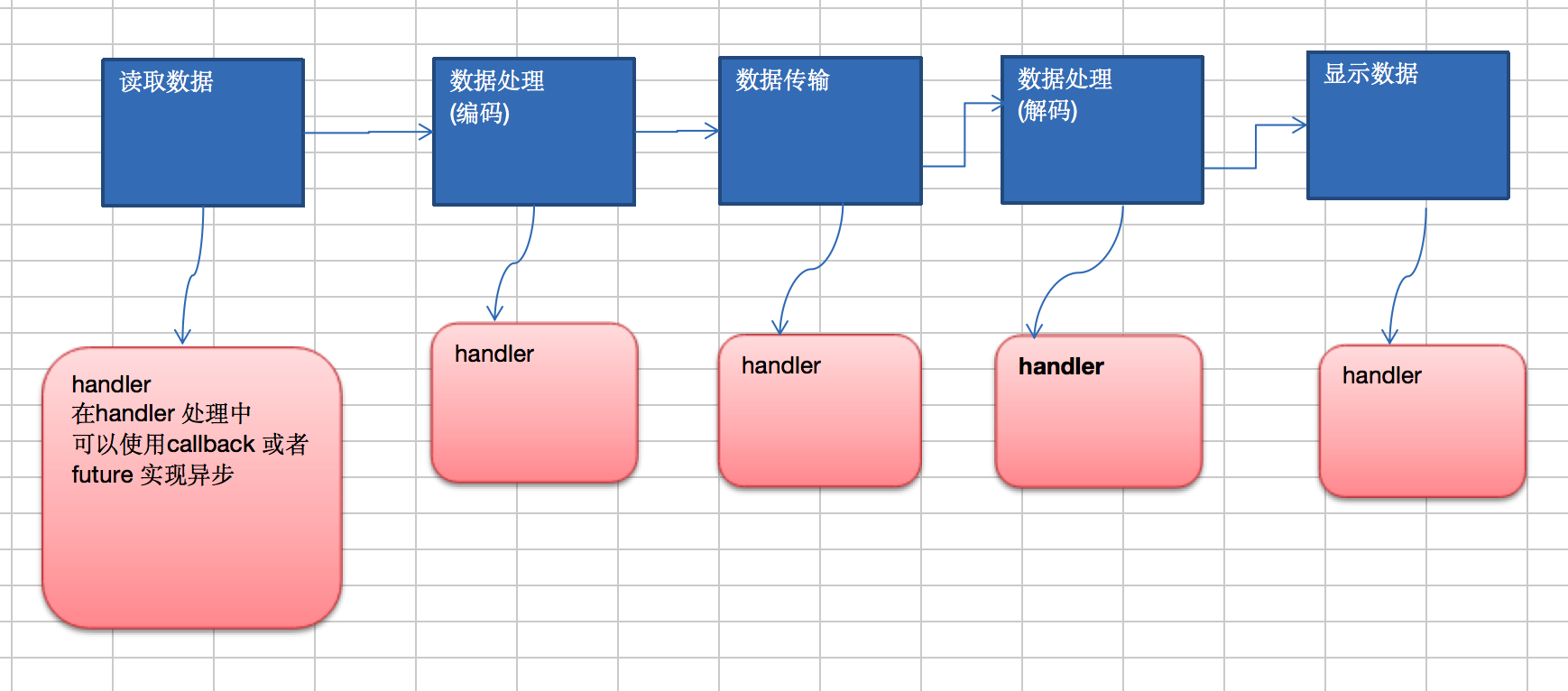
说明:
- 在使用
Netty 进行编程时,拦截操作和转换出入站数据只需要提供 Callback 或利用 Future 即可。这使得链式操作简单、高效,并有利于编写可重用的、通用的代码。
Netty 框架的目标就是让业务逻辑从网络基础应用编码中分离出来、解脱出来。
Future-Listener 机制
当 Future 对象刚刚创建时,处于非完成状态,调用者可以通过返回的 ChannelFuture 来获取操作执行的状态,注册监听函数来执行完成后的操作。
常见有如下操作:
- 通过
isDone 方法来判断当前操作是否完成;
- 通过
isSuccess 方法来判断已完成的当前操作是否成功;
- 通过
getCause 方法来获取已完成的当前操作失败的原因;
- 通过
isCancelled 方法来判断已完成的当前操作是否被取消;
- 通过
addListener 方法来注册监听器,当操作已完成(isDone方法返回完成),将会通知指定的监听器;如果 Future 对象已完成,则通知指定的监听器
举例说明:绑定端口是异步操作,当绑定操作处理完,将会调用相应的监听器处理逻辑
1
2
3
4
5
6
7
8
9
10
11
12
13
14
|
ChannelFuture cf = bootstrap.bind(6668).sync();
cf.addListener(new ChannelFutureListener() {
@Override
public void operationComplete (ChannelFuture future) throws Exception {
if (cf.isSuccess()) {
System.out.println("监听端口6668成功");
} else {
System.out.println("监听端口6668失败");
}
}
});
|
Netty 快速入门实例 - HTTP服务
- 实例要求:使用
IDEA 创建 Netty 项目
Netty 服务器在 6668 端口监听,浏览器发出请求 http://localhost:6668/- 服务器可以回复消息给客户端
"Hello!我是服务器5",并对特定请求资源进行过滤。
TestServer.java
1
2
3
4
5
6
7
8
9
10
11
12
13
14
15
16
17
18
19
20
21
22
23
24
25
26
27
28
29
30
31
32
| package com.zhao.netty.http;
import io.netty.bootstrap.ServerBootstrap;
import io.netty.channel.ChannelFuture;
import io.netty.channel.EventLoopGroup;
import io.netty.channel.nio.NioEventLoopGroup;
import io.netty.channel.socket.nio.NioServerSocketChannel;
public class TestServer {
public static void main(String[] args) throws Exception {
EventLoopGroup bossGroup = new NioEventLoopGroup(1);
EventLoopGroup workerGroup = new NioEventLoopGroup();
try {
ServerBootstrap serverBootstrap = new ServerBootstrap();
serverBootstrap.group(bossGroup, workerGroup)
.channel(NioServerSocketChannel.class)
.childHandler(new TestServerInitializer());
ChannelFuture channelFuture = serverBootstrap.bind(6668).sync();
channelFuture.channel().closeFuture().sync();
} finally {
bossGroup.shutdownGracefully();
workerGroup.shutdownGracefully();
}
}
}
|
TestServerInitializer.java
1
2
3
4
5
6
7
8
9
10
11
12
13
14
15
16
17
18
19
20
21
22
23
24
| package com.zhao.netty.http;
import io.netty.channel.ChannelInitializer;
import io.netty.channel.ChannelPipeline;
import io.netty.channel.socket.SocketChannel;
import io.netty.handler.codec.http.HttpServerCodec;
public class TestServerInitializer extends ChannelInitializer<SocketChannel> {
@Override
protected void initChannel(SocketChannel ch) throws Exception {
ChannelPipeline pipeline = ch.pipeline();
pipeline.addLast("MyHttpServerCodec", new HttpServerCodec());
pipeline.addLast("MyTestHttpServerHandler", new TestHttpServerHandler());
System.out.println("ok~~~~");
}
}
|
TestHttpServerHandler.java
1
2
3
4
5
6
7
8
9
10
11
12
13
14
15
16
17
18
19
20
21
22
23
24
25
26
27
28
29
30
31
32
33
34
35
36
37
38
39
40
41
42
43
44
45
46
47
48
49
50
51
52
53
54
55
56
57
58
59
| package com.zhao.netty.http;
import io.netty.buffer.ByteBuf;
import io.netty.buffer.Unpooled;
import io.netty.channel.ChannelHandlerContext;
import io.netty.channel.SimpleChannelInboundHandler;
import io.netty.handler.codec.http.*;
import io.netty.util.CharsetUtil;
import java.net.URI;
public class TestHttpServerHandler extends SimpleChannelInboundHandler<HttpObject> {
@Override
protected void channelRead0(ChannelHandlerContext ctx, HttpObject msg) throws Exception {
System.out.println("对应的channel=" + ctx.channel() + " pipeline=" + ctx
.pipeline() + " 通过pipeline获取channel" + ctx.pipeline().channel());
System.out.println("当前ctx的handler=" + ctx.handler());
if (msg instanceof HttpRequest) {
System.out.println("ctx 类型=" + ctx.getClass());
System.out.println("pipeline hashcode" + ctx.pipeline().hashCode() + " TestHttpServerHandler hash=" + this.hashCode());
System.out.println("msg 类型=" + msg.getClass());
System.out.println("客户端地址" + ctx.channel().remoteAddress());
HttpRequest httpRequest = (HttpRequest) msg;
URI uri = new URI(httpRequest.uri());
if ("/favicon.ico".equals(uri.getPath())) {
System.out.println("请求了 favicon.ico, 不做响应");
return;
}
ByteBuf content = Unpooled.copiedBuffer("hello, 我是服务器", CharsetUtil.UTF_8);
FullHttpResponse response = new DefaultFullHttpResponse(HttpVersion.HTTP_1_1, HttpResponseStatus.OK, content);
response.headers().set(HttpHeaderNames.CONTENT_TYPE, "text/plain");
response.headers().set(HttpHeaderNames.CONTENT_LENGTH, content.readableBytes());
ctx.writeAndFlush(response);
}
}
}
|
Netty 核心组件
Bootstrap、ServerBootstrap
Bootstrap 意思是引导,一个 Netty 应用通常由一个 Bootstrap 开始,主要作用是配置整个 Netty 程序,串联各个组件,Netty 中 Bootstrap 类是客户端程序的启动引导类,ServerBootstrap 是服务端启动引导类。
Bootstrap 常见的方法有:
public ServerBootstrap group(EventLoopGroup parentGroup, EventLoopGroup childGroup),该方法用于服务器端,用来设置两个 EventLooppublic B group(EventLoopGroup group),该方法用于客户端,用来设置一个 EventLooppublic B channel(Class<? extends C> channelClass),该方法用来设置一个服务器端的通道实现public <T> B option(ChannelOption<T> option, T value),用来给 ServerChannel 添加配置public <T> ServerBootstrap childOption(ChannelOption<T> childOption, T value),用来给接收到的通道添加配置public ServerBootstrap childHandler(ChannelHandler childHandler),该方法用来设置业务处理类(自定义的handler)public ChannelFuture bind(int inetPort),该方法用于服务器端,用来设置占用的端口号public ChannelFuture connect(String inetHost, int inetPort),该方法用于客户端,用来连接服务器端
Future、ChannelFuture
Netty 中所有的 IO 操作都是异步的,不能立刻得知消息是否被正确处理。但是可以过一会等它执行完成或者直接注册一个监听,具体的实现就是通过 Future 和 ChannelFutures,他们可以注册一个监听,当操作执行成功或失败时监听会自动触发注册的监听事件。
常见的方法有:
Channel channel(),返回当前正在进行 IO 操作的通道ChannelFuture sync(),等待异步操作执行完毕
Channel
Channel是Netty 网络通信的组件,能够用于执行网络 I/O 操作。通过 Channel 可获得当前网络连接的通道的状态和网络连接的配置参数(例如接收缓冲区大小)。
Channel 提供异步的网络 I/O 操作(如建立连接,读写,绑定端口),异步调用意味着任何 I/O 调用都将立即返回,并且不保证在调用结束时所请求的 I/O 操作已完成。调用立即返回一个 ChannelFuture 实例,通过注册监听器到 ChannelFuture 上,可以 在I/O 操作成功、失败或取消时回调通知调用方
不同协议、不同的阻塞类型的连接都有不同的Channel类型与之对应,常用的Channel类型:
NioSocketChannel,异步的客户端 TCP Socket 连接。NioServerSocketChannel,异步的服务器端 TCP Socket 连接。NioDatagramChannel,异步的 UDP 连接。NioSctpChannel,异步的客户端 Sctp 连接。NioSctpServerChannel,异步的 Sctp 服务器端连接,这些通道涵盖了 UDP 和 TCP 网络 IO 以及文件 IO。
Selector
Netty 基于 Selector 对象实现 I/O 多路复用,通过 Selector 一个线程可以监听多个连接的 Channel 事件。
当向一个 Selector 中注册 Channel 后,Selector 内部的机制就可以自动不断地查询(Select)这些注册的 Channel 是否有已就绪的 I/O 事件(例如可读,可写,网络连接完成等),这样程序就可以很简单地使用一个线程高效地管理多个 Channel
ChannelHandler 及其实现类
ChannelHandler 是一个接口,处理 I/O 事件或拦截 I/O 操作,并将其转发到其 ChannelPipeline(业务处理链)中的下一个处理程序。
ChannelHandler 本身并没有提供很多方法,因为这个接口有许多的方法需要实现,方便使用期间,可以继承它的子类。ChannelHandler 及其实现类一览图:
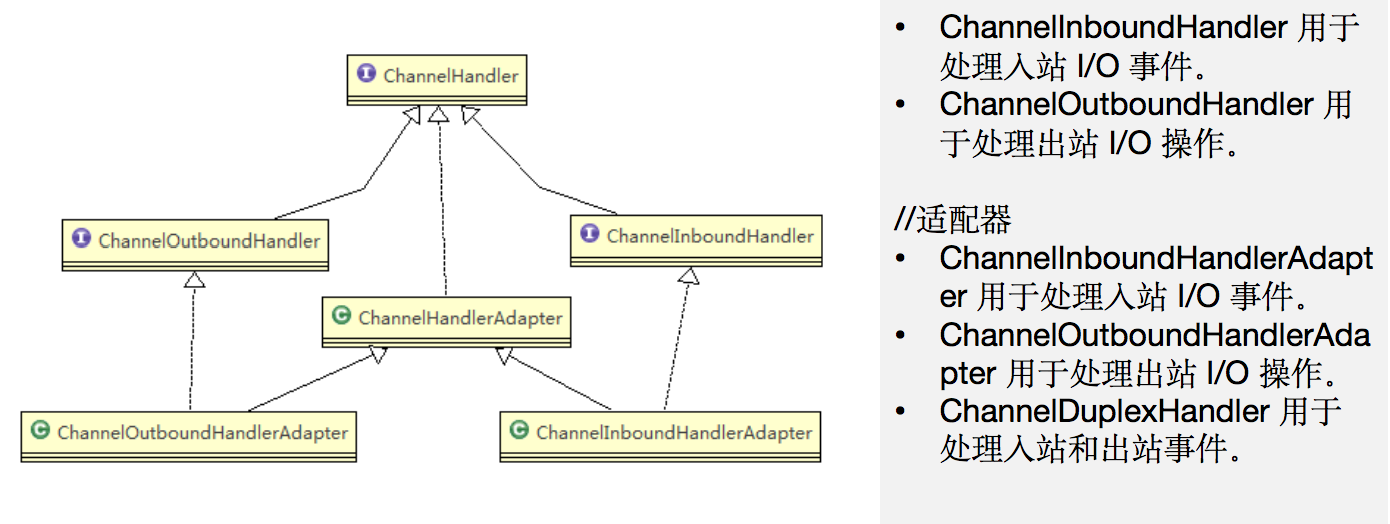
我们经常需要自定义一个 Handler 类去继承 ChannelInboundHandlerAdapter,同时根据该处理器传入的参数对象类型指定相应的泛型<>。例如处理String的Handler需要在泛型中指定<String>;处理HttpObject的Handler需要在泛型中指定<HttpObject>。
然后通过重写相应方法实现业务逻辑,一般都需要重写:
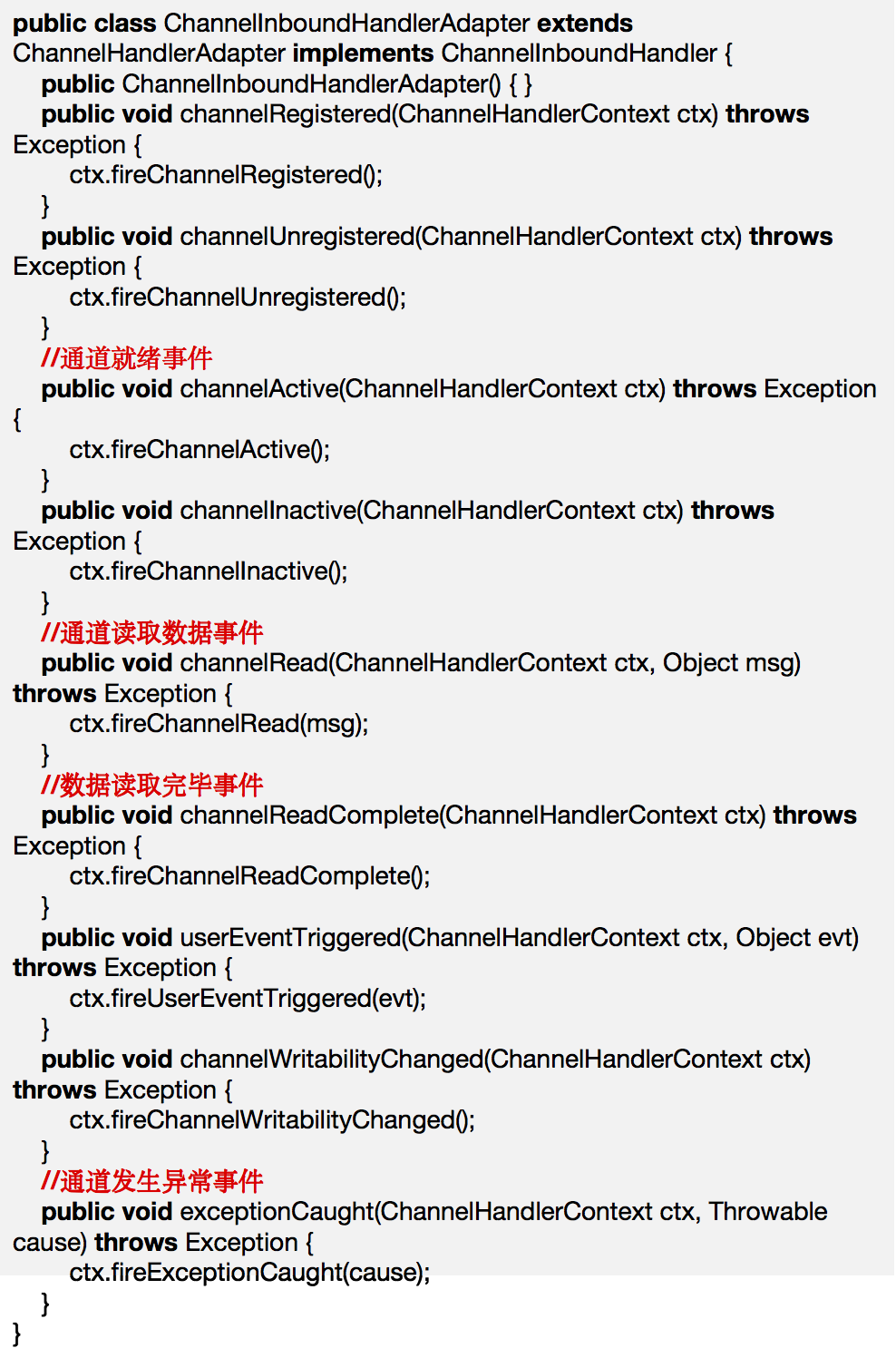
Pipeline 和 ChannelPipeline
ChannelPipeline 是一个 Handler 的集合,它负责处理和拦截 inbound 或者 outbound 的事件和操作,相当于一个贯穿 Netty 的链。(也可以这样理解:ChannelPipeline 是保存 ChannelHandler 的 List,用于处理或拦截 Channel 的入站事件和出站操作)
ChannelPipeline 实现了一种高级形式的拦截过滤器模式,使用户可以完全控制事件的处理方式,以及 Channel 中各个的 ChannelHandler 如何相互交互
在 Netty 中每个 Channel 都有且仅有一个 ChannelPipeline 与之对应,它们的组成关系如下:


入事件和出站事件在一个双向链表中,入站事件会从链表head往后传递到最后一个入站的handler,出站事件会从链表tail往前传递到最前一个出站的handler,两种类型的handler互不干扰。
常用方法:
ChannelPipeline addFirst(ChannelHandler... handlers),把一个业务处理类(handler)添加到链中的第一个位置ChannelPipeline addLast(ChannelHandler... handlers),把一个业务处理类(handler)添加到链中的最后一个位置
Pipeline双向链表中维护了一些ChannelHandlerContext,每个ChannelHandlerContext维护了一个Handler。每个ChannelHandlerContext都维护了两个属性inbound/outbound(boolean),其代表了当前Handler属于入站/出站类型。这样在Pipeline中不同类型的Handler就能区分开,从而互不干扰的工作:
Socket收到消息后,入站事件在Pipeline中按照 head -> tail 的顺序依次通过入站类型的Handler(不通过出站类型的),全部入站类型的Handler执行完毕后再按照 tail -> head 的顺序依次通过出站类型的Handler,最后通过Socket发出出站消息。

ChannelHandlerContext
ChannelHandlerContext用于保存 Channel 相关的所有上下文信息,同时关联一个 ChannelHandler 对象。即 ChannelHandlerContext 中包含一个具体的事件处理器 ChannelHandler。
Pipeline双向链表中维护了一些ChannelHandlerContext,每个ChannelHandlerContext维护了一个Handler。每个ChannelHandlerContext都维护了两个属性inbound/outbound(boolean),其代表了当前Handler属于入站/出站类型。这样在Pipeline中不同类型的Handler就能区分开,从而互不干扰的工作。
同时 ChannelHandlerContext 中也绑定了对应的 Pipeline 和 Channel 的信息,方便对 ChannelHandler 进行调用。
每一个处理器Handler都有一个对应的ChannelHandlerContext,其内保存了上一个ChannelHandlerContext:prev和下一个ChannelHandlerContext:next
常用方法:
ChannelFuture close(),关闭通道ChannelOutboundInvoker flush(),刷新ChannelFuture writeAndFlush(Object msg),将数据写到ChannelPipeline 中当前 ChannelHandler 的下一个 ChannelHandler 开始处理(出站)

ChannelOption
Netty 在创建 Channel 实例后,一般都需要设置 ChannelOption 参数。ChannelOption 参数如下:

EventLoopGroup 和其实现类 NioEventLoopGroup
EventLoopGroup 是一组 EventLoop 的抽象,Netty 为了更好的利用多核 CPU 资源,一般会有多个 EventLoop 同时工作,每个 EventLoop 维护着一个 Selector 实例。
EventLoopGroup 提供 next 接口,可以从组里面按照一定规则获取其中一个 EventLoop 来处理任务。在 Netty 服务器端编程中,我们一般都需要提供两个 EventLoopGroup,例如:BossEventLoopGroup 和 WorkerEventLoopGroup。
通常一个服务端口即一个 ServerSocketChannel 对应一个 Selector 和一个 EventLoop 线程。BossEventLoop 负责接收客户端的连接并将 SocketChannel 交给 WorkerEventLoopGroup 来进行 IO 处理,如下图所示
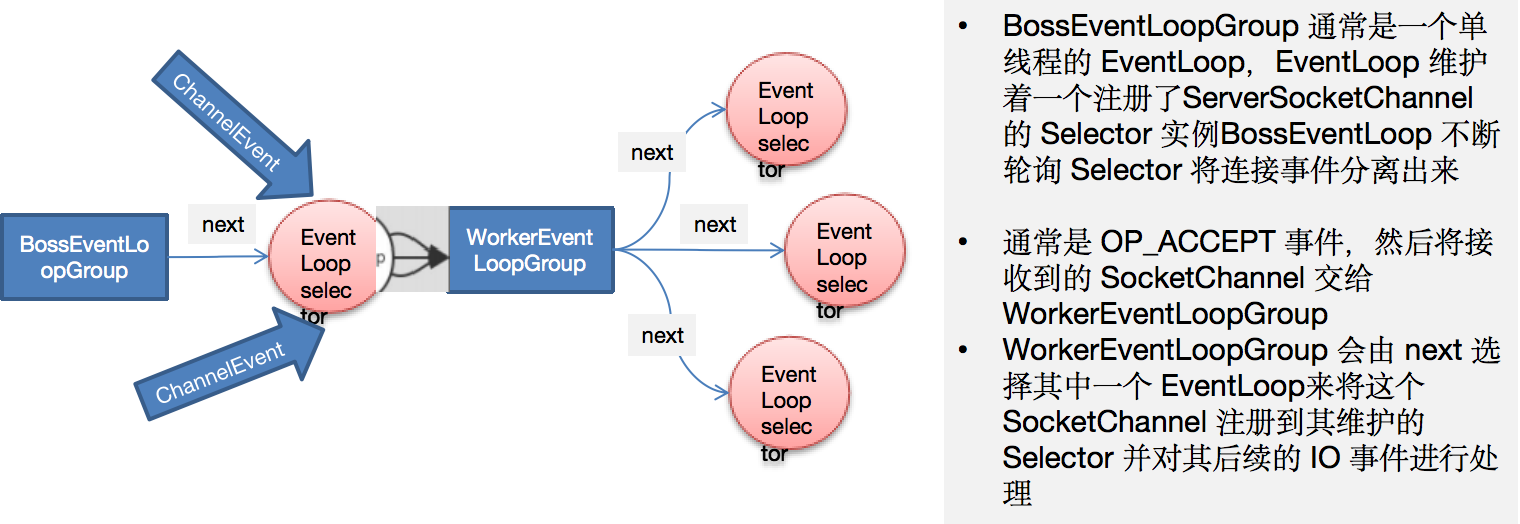
常用方法 public NioEventLoopGroup(),构造方法 public Future<?> shutdownGracefully(),断开连接,关闭线程
Unpooled 类
Netty 提供一个专门用来操作缓冲区(即 Netty 的数据容器)的工具类。常用方法如下:

举例说明 Unpooled 获取 Netty 的数据容器 ByteBuf 的基本使用

案例 1
1
2
3
4
5
6
7
8
9
10
11
12
13
14
15
16
17
18
19
20
21
22
23
24
25
26
27
28
29
30
31
32
33
34
35
| package com.zhao.netty.buf;
import io.netty.buffer.ByteBuf;
import io.netty.buffer.Unpooled;
public class NettyByteBuf01 {
public static void main(String[] args) {
ByteBuf buffer = Unpooled.buffer(10);
for (int i = 0; i < 10; i++) {
buffer.writeByte(i);
}
System.out.println("capacity=" + buffer.capacity());
for (int i = 0; i < buffer.capacity(); i++) {
System.out.println(buffer.readByte());
}
System.out.println("执行完毕");
}
}
|
案例 2
1
2
3
4
5
6
7
8
9
10
11
12
13
14
15
16
17
18
19
20
21
22
23
24
25
26
27
28
29
30
31
32
33
34
35
36
37
38
39
40
41
42
43
44
45
46
| package com.zhao.netty.buf;
import io.netty.buffer.ByteBuf;
import io.netty.buffer.Unpooled;
import java.nio.charset.Charset;
public class NettyByteBuf02 {
public static void main(String[] args) {
ByteBuf byteBuf = Unpooled.copiedBuffer("hello,world!", Charset.forName("utf-8"));
if (byteBuf.hasArray()) {
byte[] content = byteBuf.array();
System.out.println(new String(content, Charset.forName("utf-8")));
System.out.println("byteBuf=" + byteBuf);
System.out.println(byteBuf.arrayOffset());
System.out.println(byteBuf.readerIndex());
System.out.println(byteBuf.writerIndex());
System.out.println(byteBuf.capacity());
System.out.println(byteBuf.getByte(0));
int len = byteBuf.readableBytes();
System.out.println("len=" + len);
for (int i = 0; i < len; i++) {
System.out.println((char) byteBuf.getByte(i));
}
System.out.println(byteBuf.getCharSequence(0, 4, Charset.forName("utf-8")));
System.out.println(byteBuf.getCharSequence(4, 6, Charset.forName("utf-8")));
}
}
}
|
Netty 应用实例-群聊系统
实例要求:
- 编写一个
Netty 群聊系统,实现服务器端和客户端之间的数据简单通讯(非阻塞)
- 实现多人群聊
- 服务器端:可以监测用户上线,离线,并实现消息转发功能
- 客户端:通过
channel 可以无阻塞发送消息给其它所有用户,同时可以接受其它用户发送的消息(有服务器转发得到)
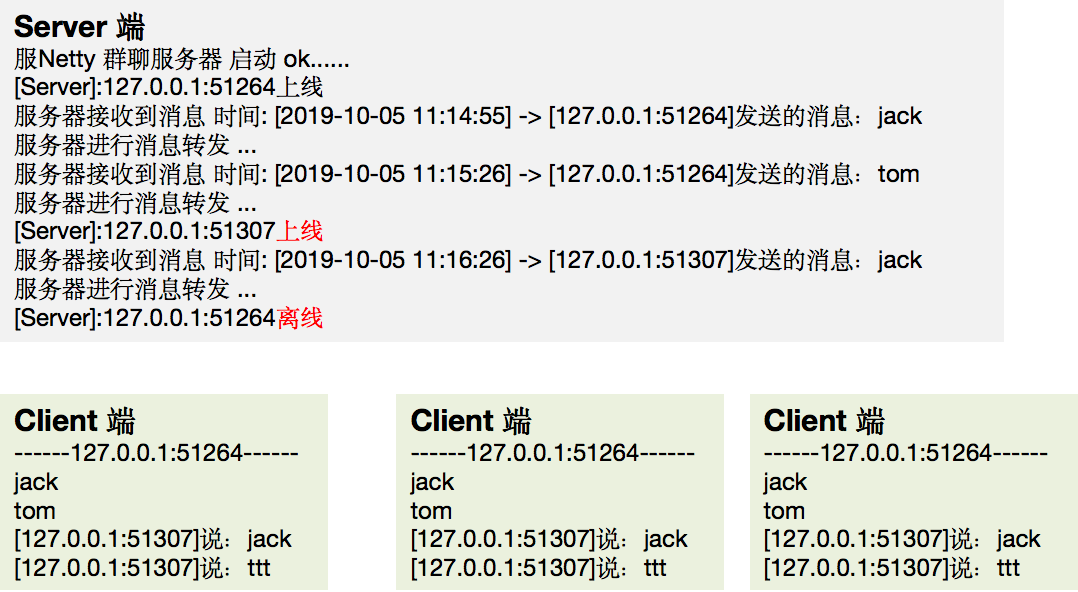
代码如下:
1
2
3
4
5
6
7
8
9
10
11
12
13
14
15
16
17
18
19
20
21
22
23
24
25
26
27
28
29
30
31
32
33
34
35
36
37
38
39
40
41
42
43
44
45
46
47
48
49
50
51
52
53
54
55
56
57
58
59
60
61
62
63
64
65
66
67
68
69
70
71
72
73
74
75
76
77
78
79
80
81
82
83
84
85
86
87
88
89
90
91
92
93
94
95
96
97
98
99
100
101
102
103
104
105
106
107
108
109
110
111
112
113
114
115
116
117
118
119
120
121
122
123
124
125
126
127
128
129
130
131
132
133
134
135
136
137
138
139
140
141
142
143
144
145
146
147
148
149
150
151
152
153
154
155
156
157
158
159
160
161
162
163
164
165
166
167
168
169
170
171
172
173
174
175
176
177
178
179
180
181
182
183
184
185
186
187
188
189
190
191
192
193
194
195
196
197
198
199
200
201
202
203
204
205
206
207
208
209
210
211
212
213
214
215
216
217
218
219
220
221
222
223
224
225
226
227
228
229
230
231
232
233
234
235
236
237
238
| package com.zhao.netty.groupchat;
import io.netty.bootstrap.ServerBootstrap;
import io.netty.channel.*;
import io.netty.channel.nio.NioEventLoopGroup;
import io.netty.channel.socket.SocketChannel;
import io.netty.channel.socket.nio.NioServerSocketChannel;
import io.netty.handler.codec.string.StringDecoder;
import io.netty.handler.codec.string.StringEncoder;
public class GroupChatServer {
private int port;
public GroupChatServer(int port) {
this.port = port;
}
public void run() throws Exception {
EventLoopGroup bossGroup = new NioEventLoopGroup(1);
EventLoopGroup workerGroup = new NioEventLoopGroup();
try {
ServerBootstrap b = new ServerBootstrap();
b.group(bossGroup, workerGroup)
.channel(NioServerSocketChannel.class)
.option(ChannelOption.SO_BACKLOG, 128)
.childOption(ChannelOption.SO_KEEPALIVE, true)
.childHandler(new ChannelInitializer<SocketChannel>() {
@Override
protected void initChannel(SocketChannel ch) throws Exception {
ChannelPipeline pipeline = ch.pipeline();
pipeline.addLast("decoder", new StringDecoder());
pipeline.addLast("encoder", new StringEncoder());
pipeline.addLast(new GroupChatServerHandler());
}
});
System.out.println("netty 服务器启动");
ChannelFuture channelFuture = b.bind(port).sync();
channelFuture.channel().closeFuture().sync();
} finally {
bossGroup.shutdownGracefully();
workerGroup.shutdownGracefully();
}
}
public static void main(String[] args) throws Exception {
new GroupChatServer(7000).run();
}
}
package com.zhao.netty.groupchat;
import io.netty.channel.Channel;
import io.netty.channel.ChannelHandlerContext;
import io.netty.channel.SimpleChannelInboundHandler;
import io.netty.channel.group.ChannelGroup;
import io.netty.channel.group.DefaultChannelGroup;
import io.netty.util.concurrent.GlobalEventExecutor;
import java.text.SimpleDateFormat;
import java.util.ArrayList;
import java.util.HashMap;
import java.util.List;
import java.util.Map;
public class GroupChatServerHandler extends SimpleChannelInboundHandler<String> {
private static ChannelGroup channelGroup = new DefaultChannelGroup(GlobalEventExecutor.INSTANCE);
SimpleDateFormat sdf = new SimpleDateFormat("yyyy-MM-dd HH:mm:ss");
@Override
public void handlerAdded(ChannelHandlerContext ctx) throws Exception {
Channel channel = ctx.channel();
channelGroup.writeAndFlush("[客户端]" + channel.remoteAddress() + " 加入聊天" + sdf.format(new java.util.Date()) + " \n");
channelGroup.add(channel);
}
@Override
public void handlerRemoved(ChannelHandlerContext ctx) throws Exception {
Channel channel = ctx.channel();
channelGroup.writeAndFlush("[客户端]" + channel.remoteAddress() + " 离开了\n");
System.out.println("channelGroup size" + channelGroup.size());
}
@Override
public void channelActive(ChannelHandlerContext ctx) throws Exception {
System.out.println(ctx.channel().remoteAddress() + " 上线了~");
}
@Override
public void channelInactive(ChannelHandlerContext ctx) throws Exception {
System.out.println(ctx.channel().remoteAddress() + " 离线了~");
}
@Override
protected void channelRead0(ChannelHandlerContext ctx, String msg) throws Exception {
Channel channel = ctx.channel();
channelGroup.forEach(ch -> {
if (channel != ch) {
ch.writeAndFlush("[客户]" + channel.remoteAddress() + " 发送了消息" + msg + "\n");
} else {
ch.writeAndFlush("[自己]发送了消息" + msg + "\n");
}
});
}
@Override
public void exceptionCaught(ChannelHandlerContext ctx, Throwable cause) throws Exception {
ctx.close();
}
}
package com.zhao.netty.groupchat;
import io.netty.bootstrap.Bootstrap;
import io.netty.channel.*;
import io.netty.channel.nio.NioEventLoopGroup;
import io.netty.channel.socket.SocketChannel;
import io.netty.channel.socket.nio.NioSocketChannel;
import io.netty.handler.codec.string.StringDecoder;
import io.netty.handler.codec.string.StringEncoder;
import java.util.Scanner;
public class GroupChatClient {
private final String host;
private final int port;
public GroupChatClient(String host, int port) {
this.host = host;
this.port = port;
}
public void run() throws Exception {
EventLoopGroup group = new NioEventLoopGroup();
try {
Bootstrap bootstrap = new Bootstrap()
.group(group)
.channel(NioSocketChannel.class)
.handler(new ChannelInitializer<SocketChannel>() {
@Override
protected void initChannel(SocketChannel ch) throws Exception {
ChannelPipeline pipeline = ch.pipeline();
pipeline.addLast("decoder", new StringDecoder());
pipeline.addLast("encoder", new StringEncoder());
pipeline.addLast(new GroupChatClientHandler());
}
});
ChannelFuture channelFuture = bootstrap.connect(host, port).sync();
Channel channel = channelFuture.channel();
System.out.println("-------" + channel.localAddress() + "--------");
Scanner scanner = new Scanner(System.in);
while (scanner.hasNextLine()) {
String msg = scanner.nextLine();
channel.writeAndFlush(msg + "\r\n");
}
} finally {
group.shutdownGracefully();
}
}
public static void main(String[] args) throws Exception {
new GroupChatClient("127.0.0.1", 7000).run();
}
}
package com.zhao.netty.groupchat;
import io.netty.channel.ChannelHandlerContext;
import io.netty.channel.SimpleChannelInboundHandler;
public class GroupChatClientHandler extends SimpleChannelInboundHandler<String> {
@Override
protected void channelRead0(ChannelHandlerContext ctx, String msg) throws Exception {
System.out.println(msg.trim());
}
}
|
Netty 心跳检测机制
使用空闲状态处理器IdleStateHandler发送读写空闲事件IdleStateEvent。当 IdleStateEvent 触发后,就会传递给管道的下一个handler去处理。通过调用(触发)下一个handler 的 userEventTiggered()方法 ,在该方法中去处理 IdleStateEvent(读空闲,写空闲,读写空闲)
实例要求:
- 编写一个
Netty 心跳检测机制案例,当服务器超过 3 秒没有读时,就提示读空闲
- 当服务器超过
5 秒没有写操作时,就提示写空闲
- 实现当服务器超过
7 秒没有读或者写操作时,就提示读写空闲
1
2
3
4
5
6
7
8
9
10
11
12
13
14
15
16
17
18
19
20
21
22
23
24
25
26
27
28
29
30
31
32
33
34
35
36
37
38
39
40
41
42
43
44
45
46
47
48
49
50
51
52
53
54
55
56
57
58
59
60
61
62
63
64
65
66
67
68
69
70
71
72
73
74
75
76
77
78
79
80
81
82
83
84
85
86
87
88
89
90
91
92
93
94
95
96
97
98
99
100
101
102
103
104
105
106
| package com.zhao.netty.heartbeat;
import io.netty.bootstrap.ServerBootstrap;
import io.netty.channel.ChannelFuture;
import io.netty.channel.ChannelInitializer;
import io.netty.channel.ChannelPipeline;
import io.netty.channel.EventLoopGroup;
import io.netty.channel.nio.NioEventLoopGroup;
import io.netty.channel.socket.SocketChannel;
import io.netty.channel.socket.nio.NioServerSocketChannel;
import io.netty.handler.logging.LogLevel;
import io.netty.handler.logging.LoggingHandler;
import io.netty.handler.timeout.IdleStateHandler;
import java.util.concurrent.TimeUnit;
public class MyServer {
public static void main(String[] args) throws Exception {
EventLoopGroup bossGroup = new NioEventLoopGroup(1);
EventLoopGroup workerGroup = new NioEventLoopGroup();
try {
ServerBootstrap serverBootstrap = new ServerBootstrap();
serverBootstrap.group(bossGroup, workerGroup);
serverBootstrap.channel(NioServerSocketChannel.class);
serverBootstrap.handler(new LoggingHandler(LogLevel.INFO));
serverBootstrap.childHandler(new ChannelInitializer<SocketChannel>() {
@Override
protected void initChannel(SocketChannel ch) throws Exception {
ChannelPipeline pipeline = ch.pipeline();
pipeline.addLast(new IdleStateHandler(7000, 7000, 10, TimeUnit.SECONDS));
pipeline.addLast(new MyServerHandler());
}
});
ChannelFuture channelFuture = serverBootstrap.bind(7000).sync();
channelFuture.channel().closeFuture().sync();
} finally {
bossGroup.shutdownGracefully();
workerGroup.shutdownGracefully();
}
}
}
package com.zhao.netty.heartbeat;
import io.netty.channel.ChannelHandlerContext;
import io.netty.channel.ChannelInboundHandlerAdapter;
import io.netty.handler.timeout.IdleStateEvent;
public class MyServerHandler extends ChannelInboundHandlerAdapter {
@Override
public void userEventTriggered(ChannelHandlerContext ctx, Object evt) throws Exception {
if (evt instanceof IdleStateEvent) {
IdleStateEvent event = (IdleStateEvent) evt;
String eventType = null;
switch (event.state()) {
case READER_IDLE:
eventType = "读空闲";
break;
case WRITER_IDLE:
eventType = "写空闲";
break;
case ALL_IDLE:
eventType = "读写空闲";
break;
}
System.out.println(ctx.channel().remoteAddress() + "--超时时间--" + eventType);
System.out.println("服务器做相应处理..");
}
}
}
|
Netty 通过 WebSocket 编程实现服务器和客户端长连接
WebSocket介绍:http://www.ruanyifeng.com/blog/2017/05/websocket.html
实例要求:
Http 协议是无状态的,浏览器和服务器间的请求响应一次,下一次会重新创建连接。- 要求:实现基于
WebSocket 的长连接的全双工的交互
- 改变
Http 协议多次请求的约束,实现长连接了,服务器可以发送消息给浏览器
- 客户端浏览器和服务器端会相互感知,比如服务器关闭了,浏览器会感知,同样浏览器关闭了,服务器会感知
1
2
3
4
5
6
7
8
9
10
11
12
13
14
15
16
17
18
19
20
21
22
23
24
25
26
27
28
29
30
31
32
33
34
35
36
37
38
39
40
41
42
43
44
45
46
47
48
49
50
51
52
53
54
55
56
57
58
59
60
61
62
63
64
65
66
67
68
69
70
71
72
73
74
75
76
77
78
79
80
81
82
83
84
85
86
87
88
89
90
91
92
93
94
95
96
97
98
99
100
101
102
103
104
105
106
107
108
109
110
111
112
113
114
115
| package com.zhao.netty.websocket;
import io.netty.bootstrap.ServerBootstrap;
import io.netty.channel.ChannelFuture;
import io.netty.channel.ChannelInitializer;
import io.netty.channel.ChannelPipeline;
import io.netty.channel.EventLoopGroup;
import io.netty.channel.nio.NioEventLoopGroup;
import io.netty.channel.socket.SocketChannel;
import io.netty.channel.socket.nio.NioServerSocketChannel;
import io.netty.handler.codec.http.HttpObjectAggregator;
import io.netty.handler.codec.http.HttpServerCodec;
import io.netty.handler.codec.http.websocketx.WebSocketServerProtocolHandler;
import io.netty.handler.logging.LogLevel;
import io.netty.handler.logging.LoggingHandler;
import io.netty.handler.stream.ChunkedWriteHandler;
public class MyServer {
public static void main(String[] args) throws Exception {
EventLoopGroup bossGroup = new NioEventLoopGroup(1);
EventLoopGroup workerGroup = new NioEventLoopGroup();
try {
ServerBootstrap serverBootstrap = new ServerBootstrap();
serverBootstrap.group(bossGroup, workerGroup);
serverBootstrap.channel(NioServerSocketChannel.class);
serverBootstrap.handler(new LoggingHandler(LogLevel.INFO));
serverBootstrap.childHandler(new ChannelInitializer<SocketChannel>() {
@Override
protected void initChannel(SocketChannel ch) throws Exception {
ChannelPipeline pipeline = ch.pipeline();
pipeline.addLast(new HttpServerCodec());
pipeline.addLast(new ChunkedWriteHandler());
pipeline.addLast(new HttpObjectAggregator(8192));
pipeline.addLast(new WebSocketServerProtocolHandler("/hello2"));
pipeline.addLast(new MyTextWebSocketFrameHandler());
}
});
ChannelFuture channelFuture = serverBootstrap.bind(7000).sync();
channelFuture.channel().closeFuture().sync();
} finally {
bossGroup.shutdownGracefully();
workerGroup.shutdownGracefully();
}
}
}
package com.zhao.netty.websocket;
import io.netty.channel.ChannelHandlerContext;
import io.netty.channel.SimpleChannelInboundHandler;
import io.netty.handler.codec.http.websocketx.TextWebSocketFrame;
import java.time.LocalDateTime;
public class MyTextWebSocketFrameHandler extends SimpleChannelInboundHandler<TextWebSocketFrame> {
@Override
protected void channelRead0(ChannelHandlerContext ctx, TextWebSocketFrame msg) throws Exception {
System.out.println("服务器收到消息 " + msg.text());
ctx.channel().writeAndFlush(new TextWebSocketFrame("服务器时间" + LocalDateTime.now() + " " + msg.text()));
}
@Override
public void handlerAdded(ChannelHandlerContext ctx) throws Exception {
System.out.println("handlerAdded 被调用" + ctx.channel().id().asLongText());
System.out.println("handlerAdded 被调用" + ctx.channel().id().asShortText());
}
@Override
public void handlerRemoved(ChannelHandlerContext ctx) throws Exception {
System.out.println("handlerRemoved 被调用" + ctx.channel().id().asLongText());
}
@Override
public void exceptionCaught(ChannelHandlerContext ctx, Throwable cause) throws Exception {
System.out.println("异常发生 " + cause.getMessage());
ctx.close();
}
}
|
hello.html
1
2
3
4
5
6
7
8
9
10
11
12
13
14
15
16
17
18
19
20
21
22
23
24
25
26
27
28
29
30
31
32
33
34
35
36
37
38
39
40
41
42
43
44
45
46
47
48
49
50
51
52
53
54
55
56
| <!DOCTYPE html>
<html lang="en">
<head>
<meta charset="UTF-8">
<title>Title</title>
</head>
<body>
<script>
var socket;
if(window.WebSocket) {
socket = new WebSocket("ws://localhost:7000/hello2");
socket.onmessage = function (ev) {
var rt = document.getElementById("responseText");
rt.value = rt.value + "\n" + ev.data;
}
socket.onopen = function (ev) {
var rt = document.getElementById("responseText");
rt.value = "连接开启了.."
}
socket.onclose = function (ev) {
var rt = document.getElementById("responseText");
rt.value = rt.value + "\n" + "连接关闭了.."
}
} else {
alert("当前浏览器不支持websocket")
}
function send(message) {
if(!window.socket) {
return;
}
if(socket.readyState == WebSocket.OPEN) {
socket.send(message)
} else {
alert("连接没有开启");
}
}
</script>
<form onsubmit="return false">
<textarea name="message" style="height: 300px; width: 300px"></textarea>
<input type="button" value="发生消息" onclick="send(this.form.message.value)">
<textarea id="responseText" style="height: 300px; width: 300px"></textarea>
<input type="button" value="清空内容" onclick="document.getElementById('responseText').value=''">
</form>
</body>
</html>
|
Google Protobuf
编码和解码的基本介绍
编写网络应用程序时,因为数据在网络中传输的都是二进制字节码数据,在发送数据时就需要编码,接收数据时就需要解码。
codec(编解码器)的组成部分有两个:decoder(解码器)和 encoder(编码器)。encoder 负责把业务数据转换成字节码数据,decoder 负责把字节码数据转换成业务数据。

Netty 本身的编码解码的机制和问题分析
Netty 自身提供了一些 codec(编解码器):
Netty 提供的编码器 StringEncoder,对字符串数据进行编码 ObjectEncoder,对Java对象进行编码…Netty 提供的解码器 StringDecoder,对字符串数据进行解码 ObjectDecoder,对 Java 对象进行解码…Netty 本身自带的 ObjectDecoder 和 ObjectEncoder 可以用来实现 POJO 对象或各种业务对象的编码和解码,底层使用的仍是Java序列化技术,而Java序列化技术本身效率就不高,存在如下问题
- 无法跨语言
- 序列化后的体积太大,是二进制编码的5倍多。
- 序列化性能太低
引出新的解决方案:Google 的 Protobuf
Protobuf
Protobuf 是 Google 发布的开源项目,全称 Google Protocol Buffers,是一种轻便高效的结构化数据存储格式,可以用于结构化数据串行化,或者说序列化。它很适合做数据存储或 RPC [远程过程调用 remote procedure call ]数据交换格式。目前很多公司使用 http + json tcp + protobuf
参考文档:https://developers.google.com/protocol-buffers/docs/proto 语言指南
Protobuf 是以 message 的方式来管理数据的。优点:
- 支持跨平台、跨语言,即[客户端和服务器端可以是不同的语言编写的](支持目前绝大多数语言,例如
C++、C#、Java、python 等)
- 高性能,高可靠性
- 使用
Protobuf 编译器能自动生成代码,Protobuf 是将类的定义使用 .proto 文件进行描述。说明,在 idea 中编写 .proto 文件时,会自动提示是否下载 .ptoto 编写插件.可以让语法高亮。
- 然后通过
protoc.exe 编译器根据 .proto 自动生成 .java 文件
Protobuf 使用示意图

Protobuf 快速入门实例
编写程序,使用 Protobuf 完成如下功能
- 客户端可以发送一个
StudentPoJo 对象到服务器(通过 Protobuf 编码)
- 服务端能接收
StudentPoJo 对象,并显示信息(通过 Protobuf 解码)
Student.proto:
1
2
3
4
5
6
7
8
| syntax = "proto3";
option java_outer_classname = "StudentPOJO";
message Student {
int32 id = 1;
string name = 2;
}
|
编译:protoc.exe --java_out=.Student.proto。将生成的 StudentPOJO 放入到项目使用。
Protobuf 快速入门实例 2
编写程序,使用 Protobuf 完成如下功能
- 客户端可以随机发送
StudentPoJo / WorkerPoJo 对象到服务器(通过 Protobuf 编码)
- 服务端能接收
StudentPoJo / WorkerPoJo 对象(需要判断是哪种类型),并显示信息(通过 Protobuf 解码)
Student.proto:
1
2
3
4
5
6
7
8
9
10
11
12
13
14
15
16
17
18
19
20
21
22
23
24
25
26
27
28
29
30
31
32
33
34
| syntax = "proto3";
option optimize_for = SPEED;
option java_package="com.zhao.netty.codec2";
option java_outer_classname="MyDataInfo";
message MyMessage {
enum DataType {
StudentType = 0;
WorkerType = 1;
}
DataType data_type = 1;
oneof dataBody {
Student student = 2;
Worker worker = 3;
}
}
message Student {
int32 id = 1;
string name = 2;
}
message Worker {
string name=1;
int32 age=2;
}
|
https://www.bilibili.com/video/BV1DJ411m7NR?p=77
Netty 编解码器和 Handler 调用机制
基本说明
Netty 的组件设计:Netty 的主要组件有 Channel、EventLoop、ChannelFuture、ChannelHandler、ChannelPipe 等
ChannelHandler 充当了处理入站和出站数据的应用程序逻辑的容器。例如,实现 ChannelInboundHandler 接口(或 ChannelInboundHandlerAdapter),你就可以接收入站事件和数据,这些数据会被业务逻辑处理。当要给客户端发送响应时,也可以从 ChannelInboundHandler 冲刷数据。业务逻辑通常写在一个或者多个 ChannelInboundHandler 中。ChannelOutboundHandler 原理一样,只不过它是用来处理出站数据的
ChannelPipeline 提供了 ChannelHandler 链的容器。以客户端应用程序为例,如果事件的运动方向是从客户端到服务端的,那么我们称这些事件为出站的,即客户端发送给服务端的数据会通过 pipeline 中的一系列 ChannelOutboundHandler,并被这些 Handler 处理,反之则称为入站的。
Pipeline双向链表中维护了一些ChannelHandlerContext,每个ChannelHandlerContext维护了一个Handler。每个ChannelHandlerContext都维护了两个属性inbound/outbound(boolean),其代表了当前Handler属于入站/出站类型。这样在Pipeline中不同类型的Handler就能区分开,从而互不干扰的工作:
Socket收到消息后,入站事件在Pipeline中按照 head -> tail 的顺序依次通过入站类型的Handler(不通过出站类型的),全部入站类型的Handler执行完毕后再按照 tail -> head 的顺序依次通过出站类型的Handler,最后通过Socket发出出站消息。

编码解码器
当 Netty 发送或者接受一个消息的时候,就将会发生一次数据转换。入站消息会被解码:从字节转换为另一种格式(比如 java 对象);如果是出站消息,它会被编码成字节。
Netty 提供一系列实用的编解码器,他们都实现了 ChannelInboundHadnler 或者 ChannelOutboundHandler 接口。在这些类中,channelRead 方法已经被重写了。以入站为例,对于每个从入站 Channel 读取的消息,这个方法会被调用。随后,它将调用由解码器所提供的 decode() 方法进行解码,并将已经解码的字节转发给 ChannelPipeline 中的下一个 ChannelInboundHandler。
解码器 - ByteToMessageDecoder
关系继承图
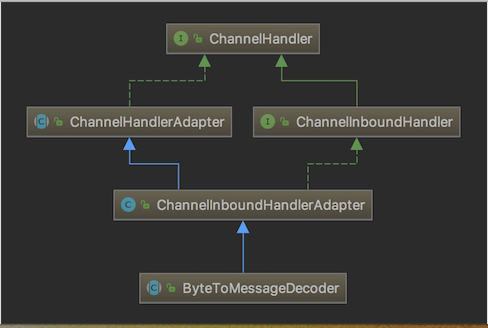
由于不可能知道远程节点是否会一次性发送一个完整的信息,tcp 有可能出现粘包拆包的问题,这个类会对入站数据进行缓冲,直到它准备好被处理.
一个关于 ByteToMessageDecoder 实例分析
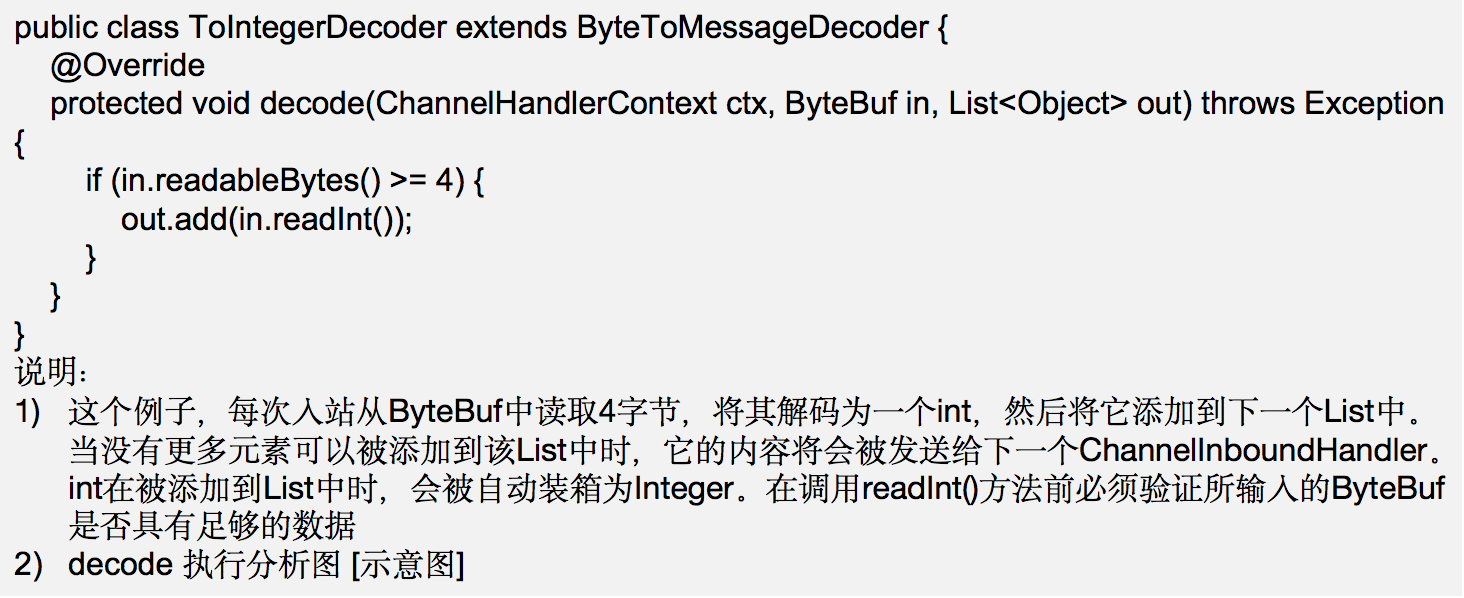
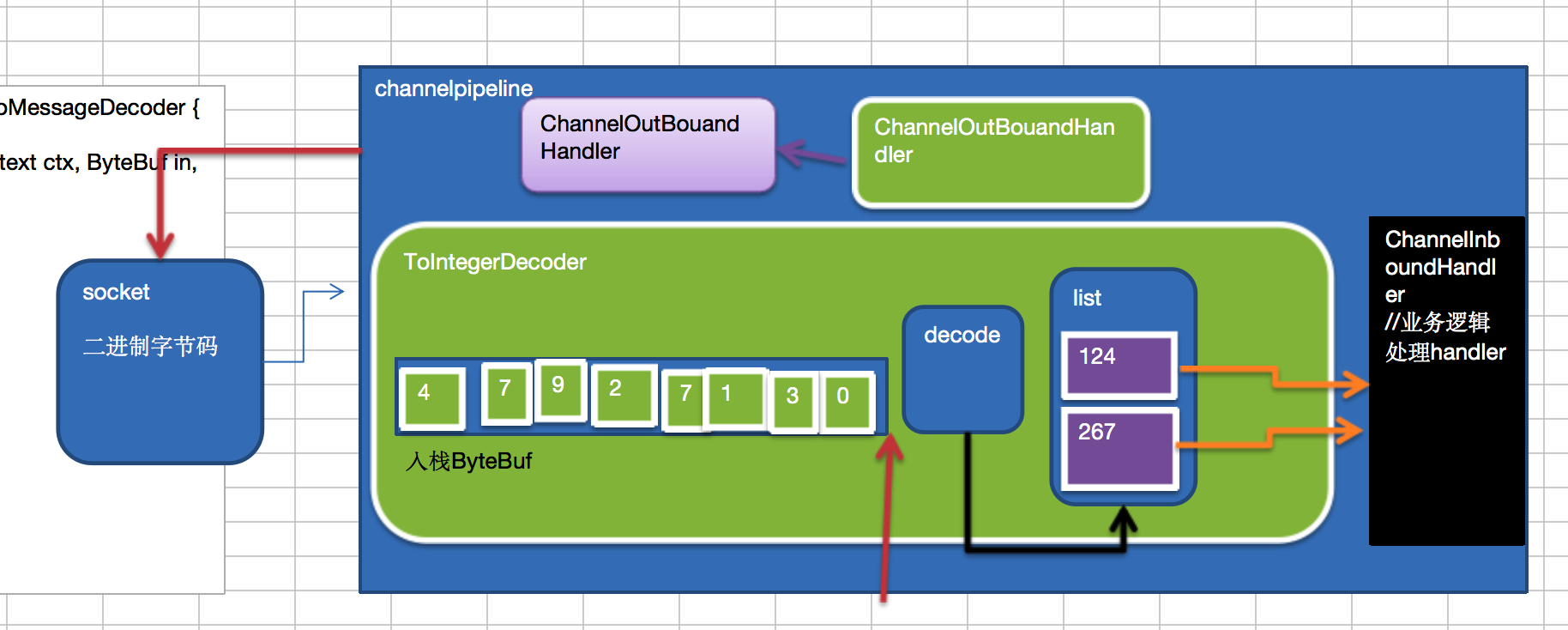
Netty 的 handler 链的调用机制
Pipeline双向链表中维护了一些ChannelHandlerContext,每个ChannelHandlerContext维护了一个Handler。每个ChannelHandlerContext都维护了两个属性inbound/outbound(boolean),其代表了当前Handler属于入站/出站类型。这样在Pipeline中不同类型的Handler就能区分开,从而互不干扰的工作:
Socket收到消息后,入站事件在Pipeline中按照 head -> tail 的顺序依次通过入站类型的Handler(不通过出站类型的),全部入站类型的Handler执行完毕后再按照 tail -> head 的顺序依次通过出站类型的Handler,最后通过Socket发出出站消息。
- 不论解码器
handler 还是编码器 handler 即接收的消息类型必须与待处理的消息类型一致,否则该 handler 不会被执行
- 在解码器进行数据解码时,需要判断缓存区(
ByteBuf)的数据是否足够,否则接收到的结果会期望结果可能不一致
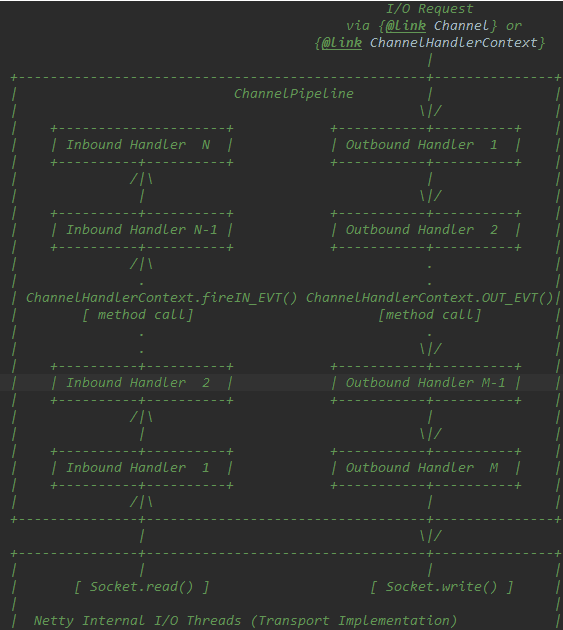
解码器 - ReplayingDecoder
public abstract class ReplayingDecoder<S> extends ByteToMessageDecoder
ReplayingDecoder 扩展了 ByteToMessageDecoder 类,使用这个类,我们不必调用 readableBytes() 方法。参数 S 指定了用户状态管理的类型,其中 Void 代表不需要状态管理
应用实例:使用 ReplayingDecoder 编写解码器,对前面的案例进行简化
1
2
3
4
5
6
7
8
9
10
11
12
13
14
15
16
17
| package com.zhao.netty.inboundhandlerandoutboundhandler;
import io.netty.buffer.ByteBuf;
import io.netty.channel.ChannelHandlerContext;
import io.netty.handler.codec.ReplayingDecoder;
import java.util.List;
public class MyByteToLongDecoder2 extends ReplayingDecoder<Void> {
@Override
protected void decode(ChannelHandlerContext ctx, ByteBuf in, List<Object> out) throws Exception {
System.out.println("MyByteToLongDecoder2 被调用");
out.add(in.readLong());
}
}
|
ReplayingDecoder使用方便,但它也有一些局限性:
- 并不是所有的
ByteBuf 操作都被支持,如果调用了一个不被支持的方法,将会抛出一个 UnsupportedOperationException。
ReplayingDecoder 在某些情况下可能稍慢于 ByteToMessageDecoder,例如网络缓慢并且消息格式复杂时,消息会被拆成了多个碎片,速度变慢
其它编解码器
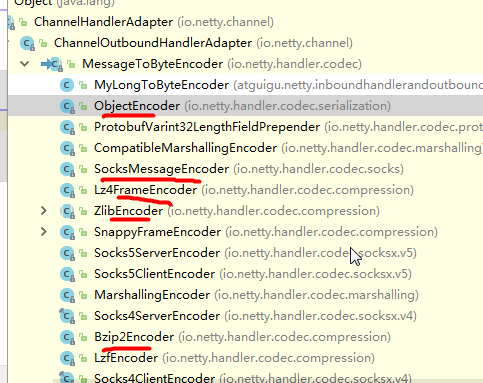
LineBasedFrameDecoder:这个类在 Netty 内部也有使用,它使用行尾控制字符(\n或者\r\n)作为分隔符来解析数据。DelimiterBasedFrameDecoder:使用自定义的特殊字符作为消息的分隔符。HttpObjectDecoder:一个 HTTP 数据的解码器LengthFieldBasedFrameDecoder:通过指定长度来标识整包消息,这样就可以自动的处理黏包和半包消息。
TCP 粘包和拆包及解决方案
TCP 粘包和拆包基本介绍
TCP 是面向连接的,面向流的,提供高可靠性服务。收发两端(客户端和服务器端)都要有一一成对的 socket,因此,发送端为了将多个发给接收端的包,更有效的发给对方,使用了优化方法(Nagle 算法),将多次间隔较小且数据量小的数据,合并成一个大的数据块,然后进行封包。这样做虽然提高了效率,但是接收端就难于分辨出完整的数据包了,因为面向流的通信是无消息保护边界的
由于 TCP 无消息保护边界,需要在接收端处理消息边界问题,也就是我们所说的粘包、拆包问题
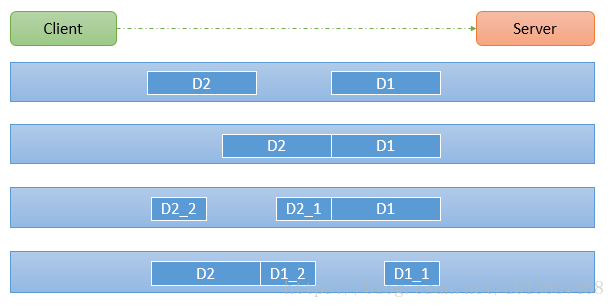
对图的说明: 假设客户端分别发送了两个数据包 D1 和 D2 给服务端,由于服务端一次读取到字节数是不确定的,故可能存在以下四种情况:
- 服务端分两次读取到了两个独立的数据包,分别是
D1 和 D2,没有粘包和拆包
- 服务端一次接受到了两个数据包,
D1 和 D2 粘合在一起,称之为 TCP 粘包
- 服务端分两次读取到了数据包,第一次读取到了完整的
D1 包和 D2 包的部分内容,第二次读取到了 D2 包的剩余内容,这称之为 TCP 拆包
- 服务端分两次读取到了数据包,第一次读取到了
D1 包的部分内容 D1_1,第二次读取到了 D1 包的剩余部分内容 D1_2 和完整的 D2 包。
TCP 粘包和拆包现象实例
在编写 Netty 程序时,如果没有做处理,就会发生粘包和拆包的问题
MyClientHandler.java
1
2
3
4
5
6
7
8
9
10
11
12
13
14
15
16
17
18
19
20
21
22
23
24
25
26
27
28
29
30
31
32
33
34
35
36
37
38
39
| package com.zhao.netty.tcp;
import io.netty.buffer.ByteBuf;
import io.netty.buffer.Unpooled;
import io.netty.channel.ChannelHandlerContext;
import io.netty.channel.SimpleChannelInboundHandler;
import java.nio.charset.Charset;
public class MyClientHandler extends SimpleChannelInboundHandler<ByteBuf> {
private int count;
@Override
public void channelActive(ChannelHandlerContext ctx) throws Exception {
for (int i = 0; i < 10; ++i) {
ByteBuf buffer = Unpooled.copiedBuffer("hello,server " + i, Charset.forName("utf-8"));
ctx.writeAndFlush(buffer);
}
}
@Override
protected void channelRead0(ChannelHandlerContext ctx, ByteBuf msg) throws Exception {
byte[] buffer = new byte[msg.readableBytes()];
msg.readBytes(buffer);
String message = new String(buffer, Charset.forName("utf-8"));
System.out.println("客户端接收到消息=" + message);
System.out.println("客户端接收消息数量=" + (++this.count));
}
@Override
public void exceptionCaught(ChannelHandlerContext ctx, Throwable cause) throws Exception {
cause.printStackTrace();
ctx.close();
}
}
|
MyServerHandler.java
1
2
3
4
5
6
7
8
9
10
11
12
13
14
15
16
17
18
19
20
21
22
23
24
25
26
27
28
29
30
31
32
33
34
35
36
37
38
| package com.zhao.netty.tcp;
import io.netty.buffer.ByteBuf;
import io.netty.buffer.Unpooled;
import io.netty.channel.ChannelHandlerContext;
import io.netty.channel.SimpleChannelInboundHandler;
import java.nio.charset.Charset;
import java.util.UUID;
public class MyServerHandler extends SimpleChannelInboundHandler<ByteBuf> {
private int count;
@Override
public void exceptionCaught(ChannelHandlerContext ctx, Throwable cause) throws Exception {
ctx.close();
}
@Override
protected void channelRead0(ChannelHandlerContext ctx, ByteBuf msg) throws Exception {
byte[] buffer = new byte[msg.readableBytes()];
msg.readBytes(buffer);
String message = new String(buffer, Charset.forName("utf-8"));
System.out.println("服务器接收到数据 " + message);
System.out.println("服务器接收到消息量=" + (++this.count));
ByteBuf responseByteBuf = Unpooled.copiedBuffer(UUID.randomUUID().toString() + " ", Charset.forName("utf-8"));
ctx.writeAndFlush(responseByteBuf);
}
}
|
TCP 粘包和拆包解决方案
- 使用自定义协议+编解码器来解决
- 关键就是要解决服务器端每次读取数据长度的问题,这个问题解决,就不会出现服务器多读或少读数据的问题,从而避免的
TCP 粘包、拆包。
实例
- 要求客户端发送
5 个 Message 对象,客户端每次发送一个 Message 对象
- 服务器端每次接收一个
Message,分 5 次进行解码,每读取到一个 Message,会回复一个 Message 对象给客户端。

1
2
3
4
5
6
7
8
9
10
11
12
13
14
15
16
17
18
19
20
21
22
23
24
25
26
27
28
29
30
31
32
33
34
35
36
37
38
39
40
41
42
43
44
45
46
47
48
49
50
51
52
53
54
55
56
57
58
59
60
61
62
63
64
65
66
67
68
69
70
71
72
73
74
75
76
77
78
79
80
81
82
83
84
85
86
87
88
89
90
91
92
93
94
95
96
97
98
99
100
101
102
103
104
105
106
107
108
109
110
111
112
113
114
115
116
117
118
119
120
121
122
123
124
125
126
127
128
129
130
131
132
133
134
135
136
137
138
139
140
141
142
143
144
145
146
147
148
149
150
151
152
153
154
155
156
157
158
159
160
161
162
163
| package com.zhao.netty.protocoltcp;
public class MessageProtocol {
private int len;
private byte[] content;
public int getLen() {
return len;
}
public void setLen(int len) {
this.len = len;
}
public byte[] getContent() {
return content;
}
public void setContent(byte[] content) {
this.content = content;
}
}
package com.zhao.netty.protocoltcp;
import io.netty.channel.ChannelHandlerContext;
import io.netty.channel.SimpleChannelInboundHandler;
import java.nio.charset.Charset;
public class MyClientHandler extends SimpleChannelInboundHandler<MessageProtocol> {
private int count;
@Override
public void channelActive(ChannelHandlerContext ctx) throws Exception {
for (int i = 0; i < 5; i++) {
String mes = "今天天气冷,吃火锅";
byte[] content = mes.getBytes(Charset.forName("utf-8"));
int length = mes.getBytes(Charset.forName("utf-8")).length;
MessageProtocol messageProtocol = new MessageProtocol();
messageProtocol.setLen(length);
messageProtocol.setContent(content);
ctx.writeAndFlush(messageProtocol);
}
}
@Override
protected void channelRead0(ChannelHandlerContext ctx, MessageProtocol msg) throws Exception {
int len = msg.getLen();
byte[] content = msg.getContent();
System.out.println("客户端接收到消息如下");
System.out.println("长度=" + len);
System.out.println("内容=" + new String(content, Charset.forName("utf-8")));
System.out.println("客户端接收消息数量=" + (++this.count));
}
@Override
public void exceptionCaught(ChannelHandlerContext ctx, Throwable cause) throws Exception {
System.out.println("异常消息=" + cause.getMessage());
ctx.close();
}
}
package com.zhao.netty.protocoltcp;
import io.netty.buffer.ByteBuf;
import io.netty.channel.ChannelHandlerContext;
import io.netty.handler.codec.MessageToByteEncoder;
public class MyMessageEncoder extends MessageToByteEncoder<MessageProtocol> {
@Override
protected void encode(ChannelHandlerContext ctx, MessageProtocol msg, ByteBuf out) throws Exception {
System.out.println("MyMessageEncoder encode 方法被调用");
out.writeInt(msg.getLen());
out.writeBytes(msg.getContent());
}
}
package com.zhao.netty.protocoltcp;
import io.netty.buffer.ByteBuf;
import io.netty.channel.ChannelHandlerContext;
import io.netty.handler.codec.ReplayingDecoder;
import java.util.List;
public class MyMessageDecoder extends ReplayingDecoder<Void> {
@Override
protected void decode(ChannelHandlerContext ctx, ByteBuf in, List<Object> out) throws Exception {
System.out.println("MyMessageDecoder decode 被调用");
int length = in.readInt();
byte[] content = new byte[length];
in.readBytes(content);
MessageProtocol messageProtocol = new MessageProtocol();
messageProtocol.setLen(length);
messageProtocol.setContent(content);
out.add(messageProtocol);
}
}
package com.zhao.netty.protocoltcp;
import io.netty.channel.ChannelHandlerContext;
import io.netty.channel.SimpleChannelInboundHandler;
import java.nio.charset.Charset;
import java.util.UUID;
public class MyServerHandler extends SimpleChannelInboundHandler<MessageProtocol> {
private int count;
@Override
public void exceptionCaught(ChannelHandlerContext ctx, Throwable cause) throws Exception {
ctx.close();
}
@Override
protected void channelRead0(ChannelHandlerContext ctx, MessageProtocol msg) throws Exception {
int len = msg.getLen();
byte[] content = msg.getContent();
System.out.println();
System.out.println();
System.out.println();
System.out.println("服务器接收到信息如下");
System.out.println("长度=" + len);
System.out.println("内容=" + new String(content, Charset.forName("utf-8")));
System.out.println("服务器接收到消息包数量=" + (++this.count));
String responseContent = UUID.randomUUID().toString();
int responseLen = responseContent.getBytes("utf-8").length;
byte[] responseContent2 = responseContent.getBytes("utf-8");
MessageProtocol messageProtocol = new MessageProtocol();
messageProtocol.setLen(responseLen);
messageProtocol.setContent(responseContent2);
ctx.writeAndFlush(messageProtocol);
}
}
|
zhao


































